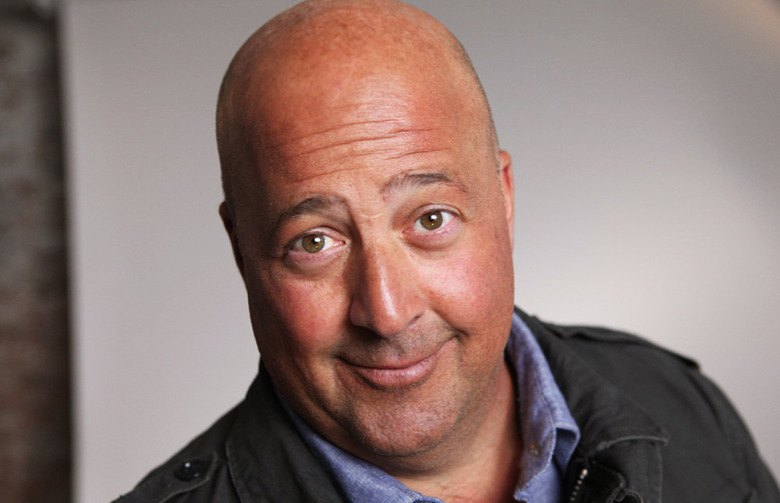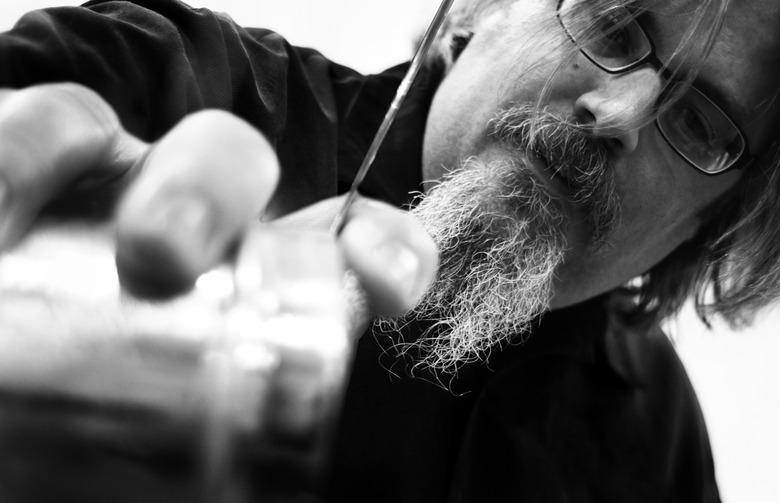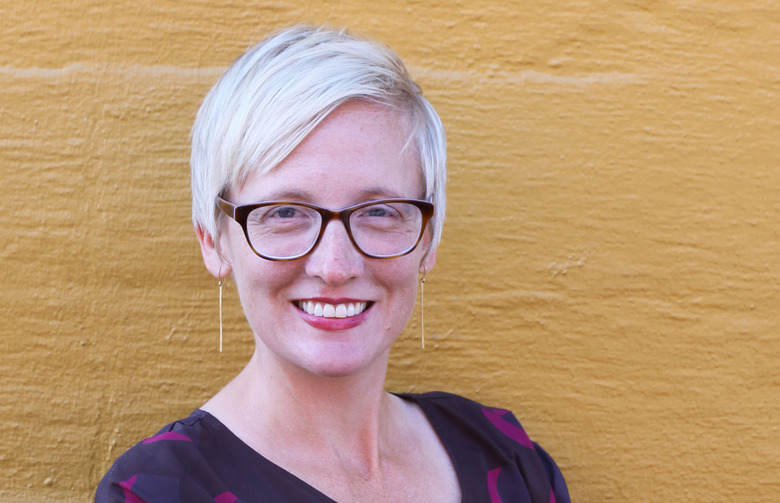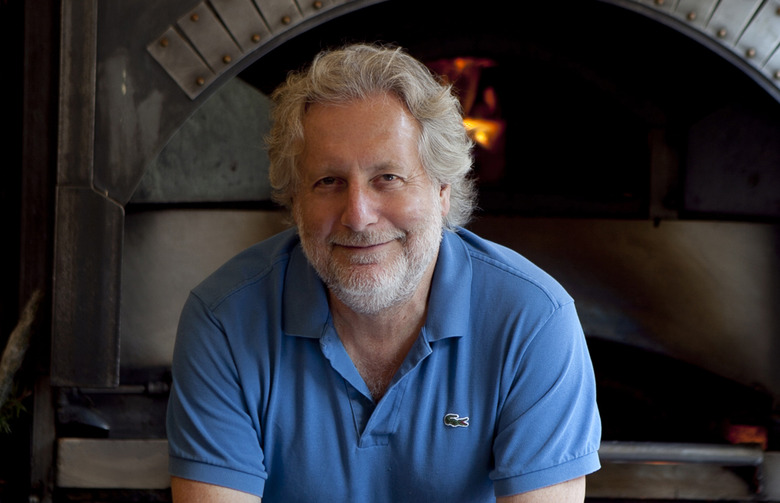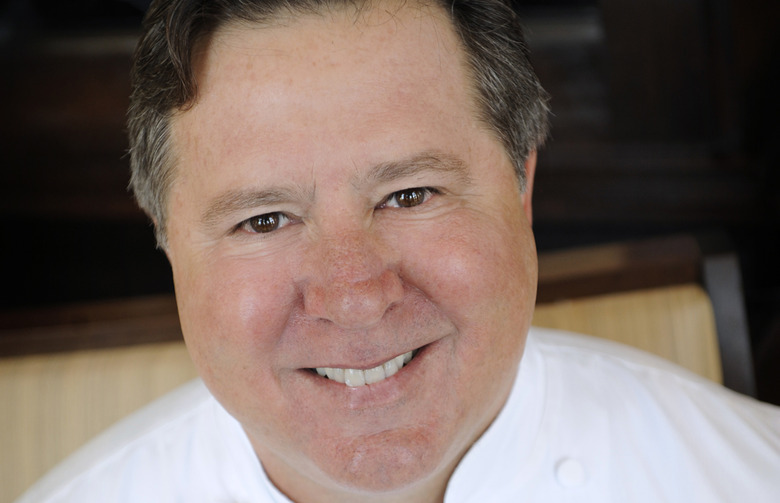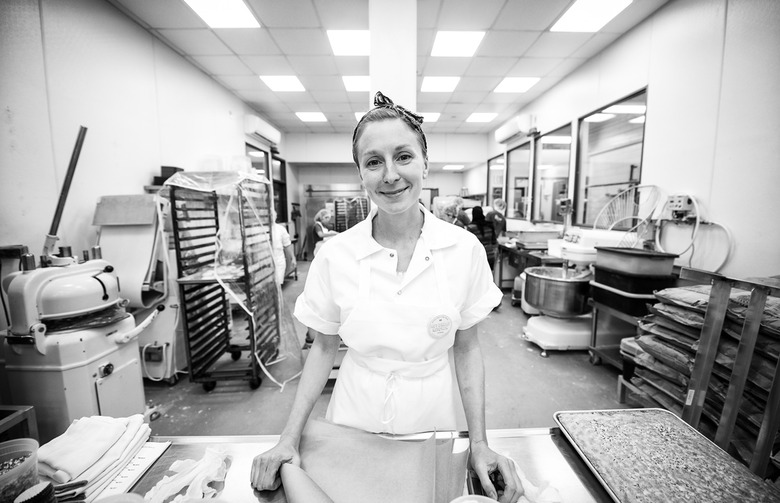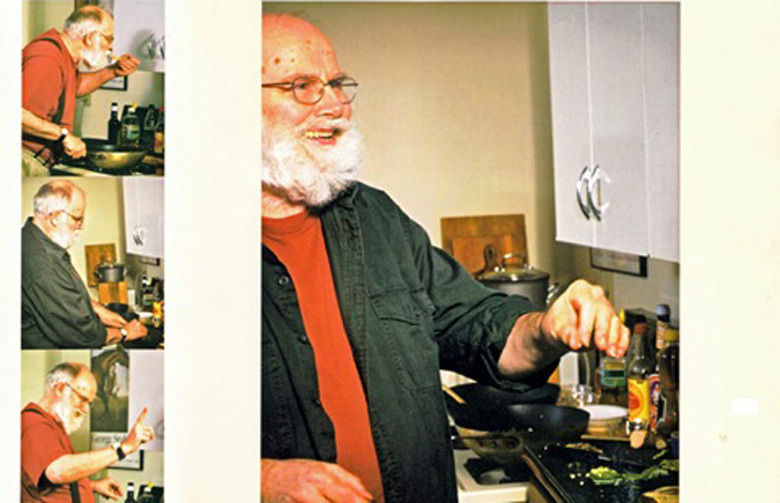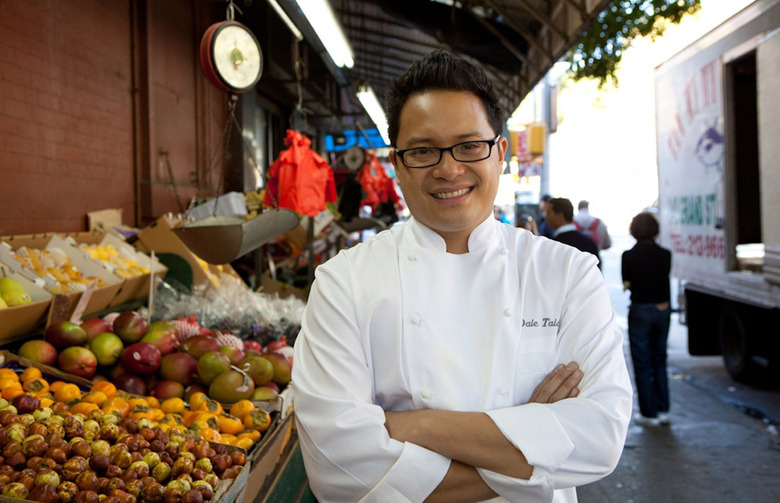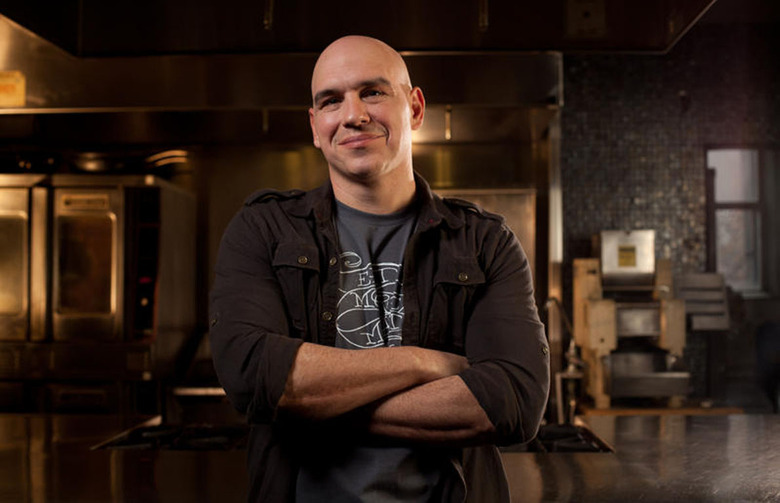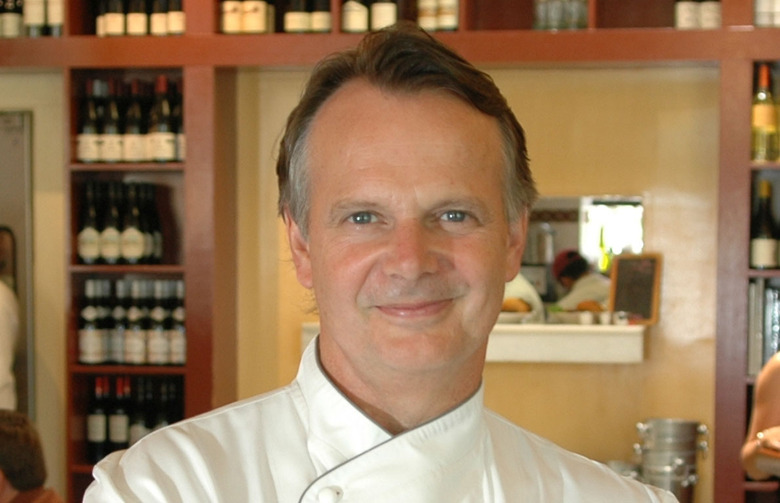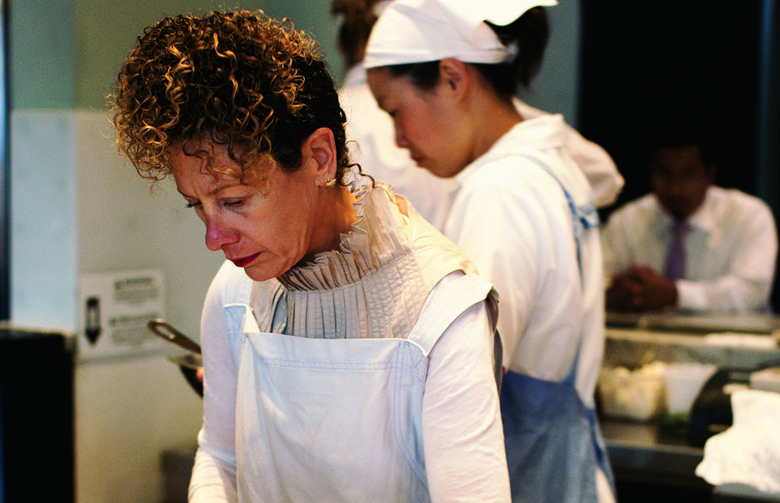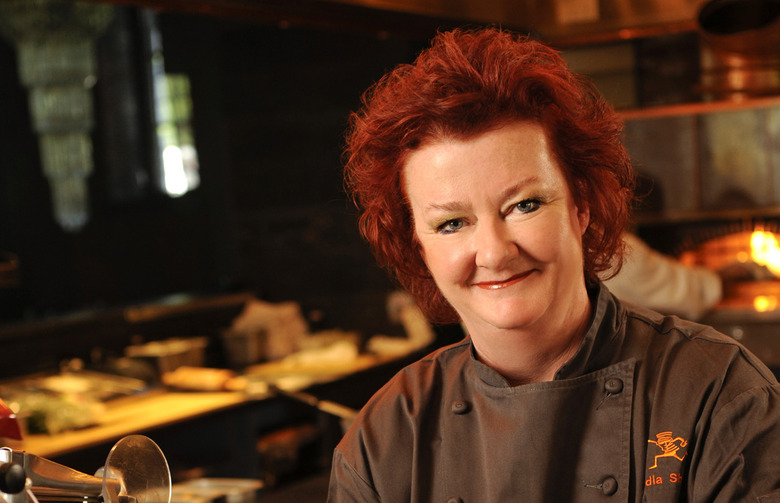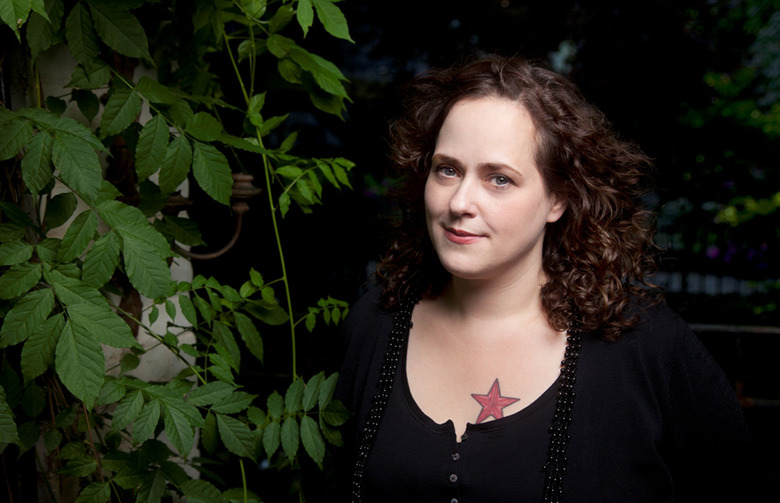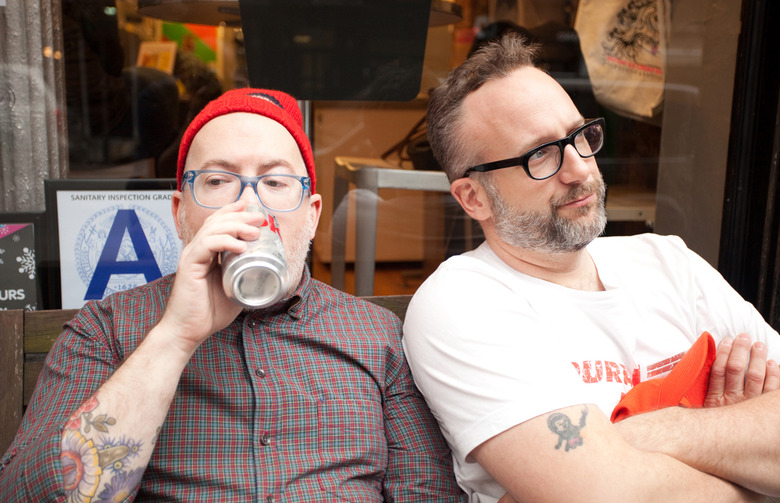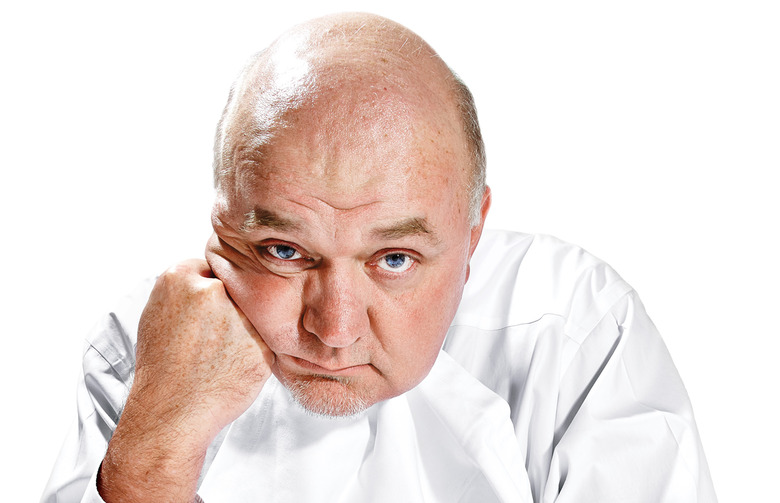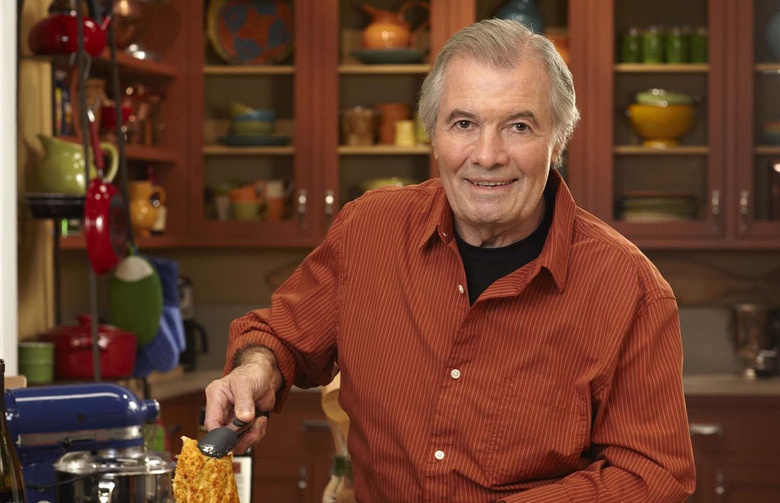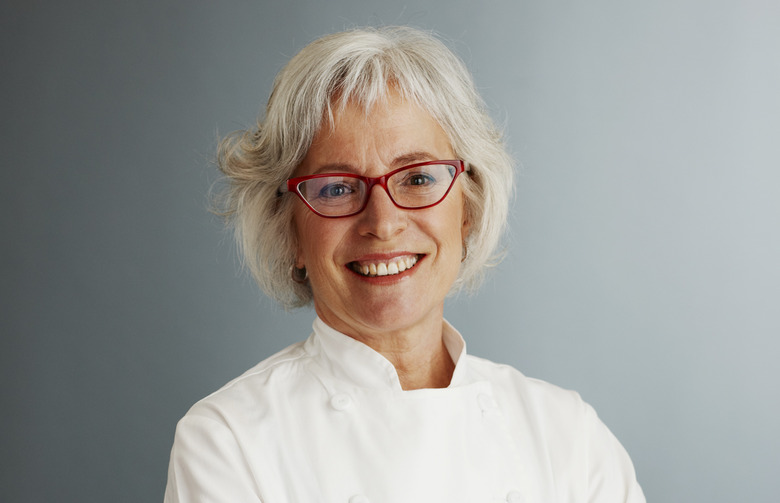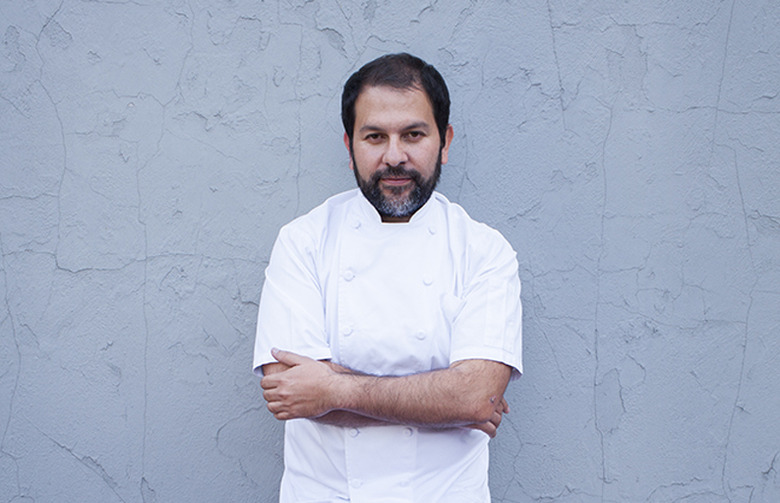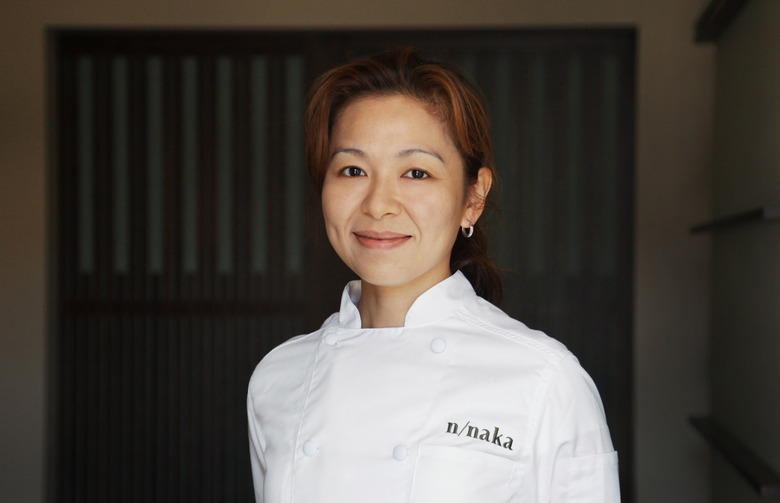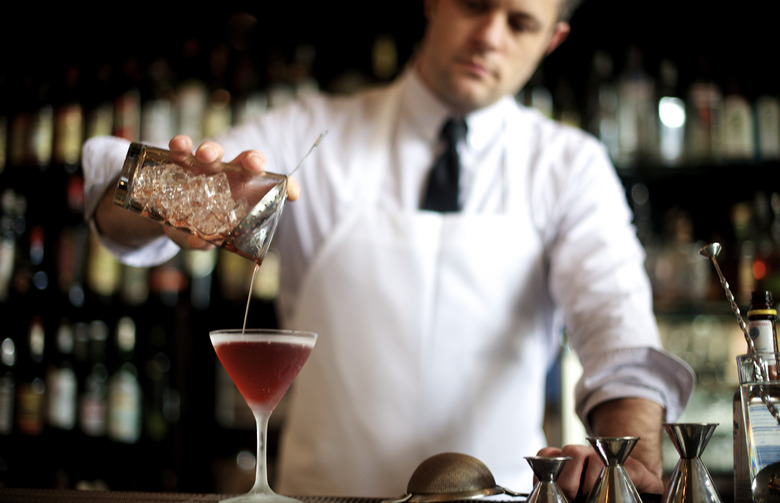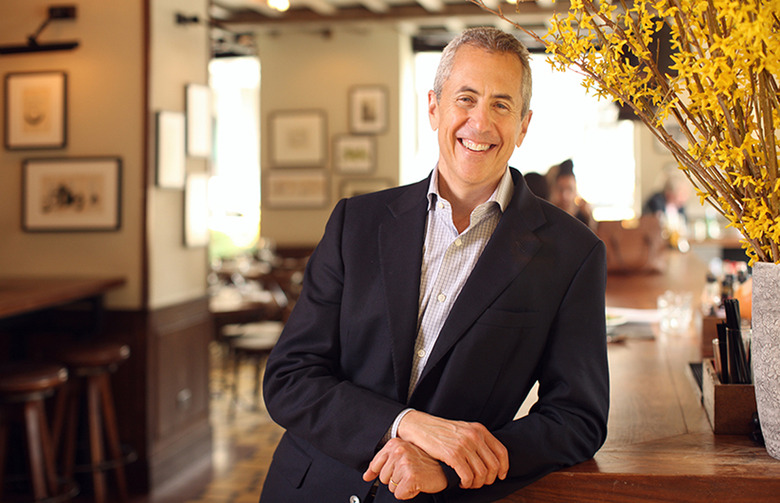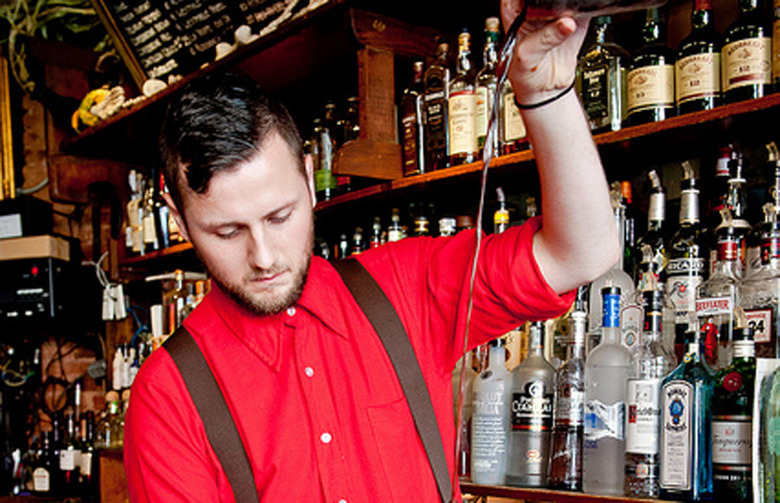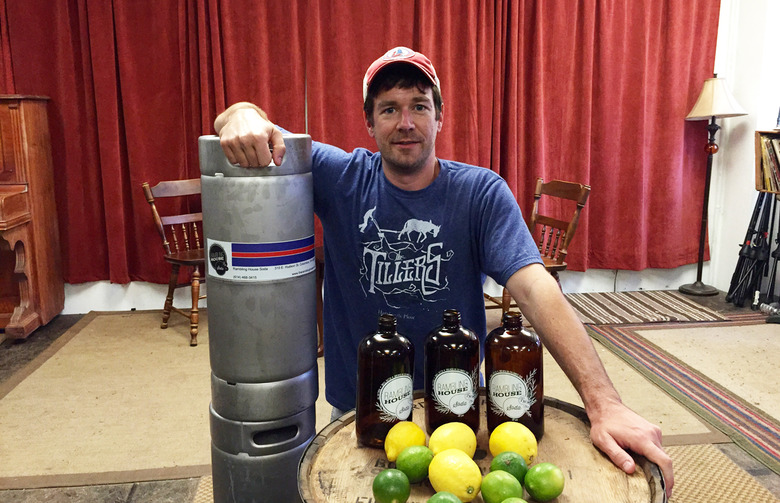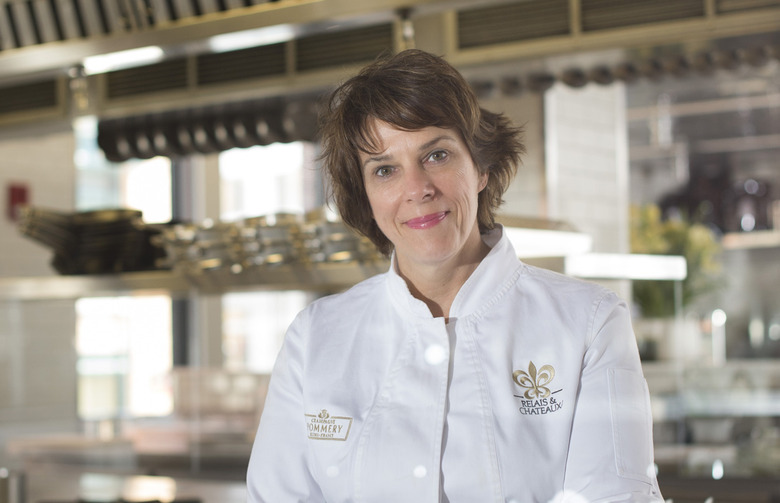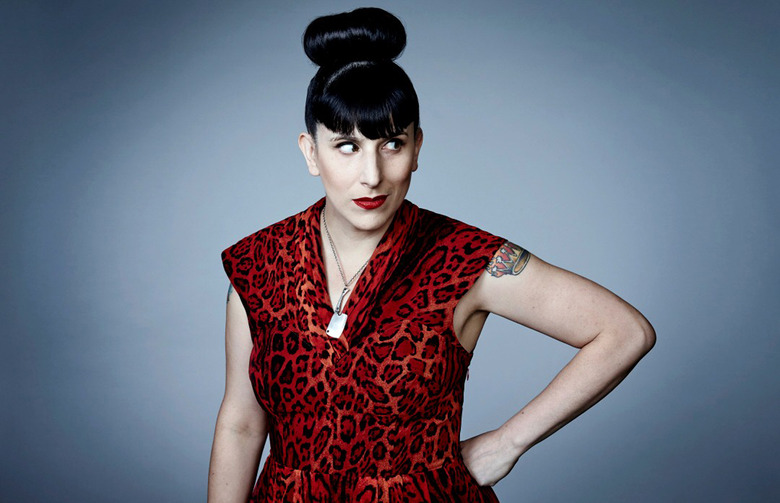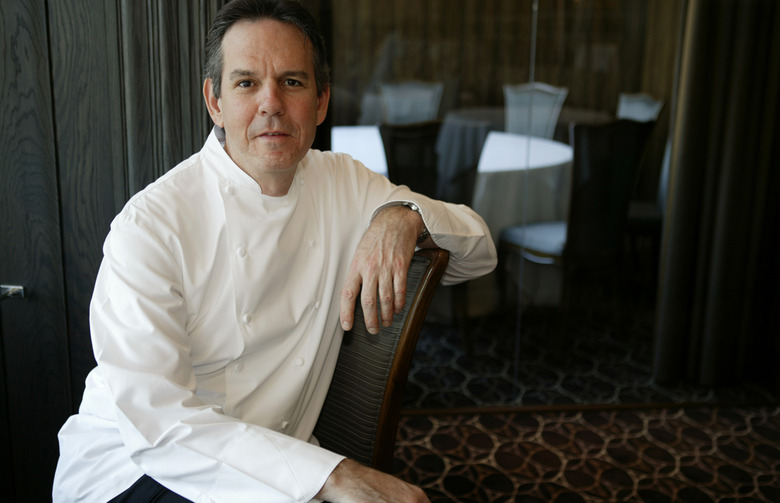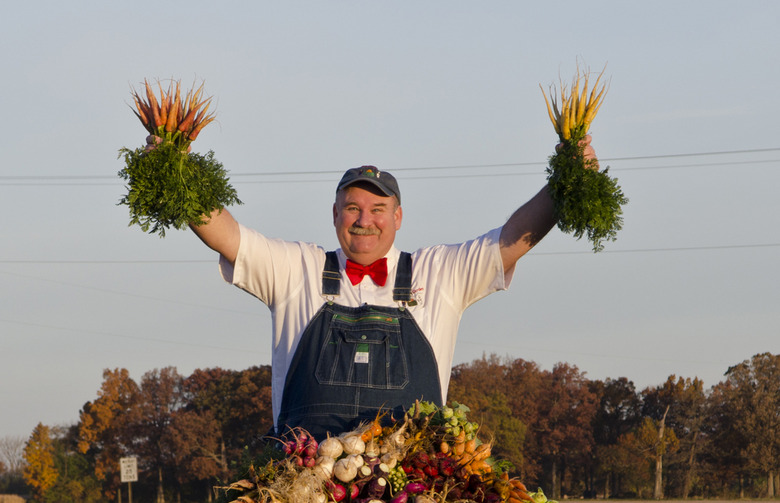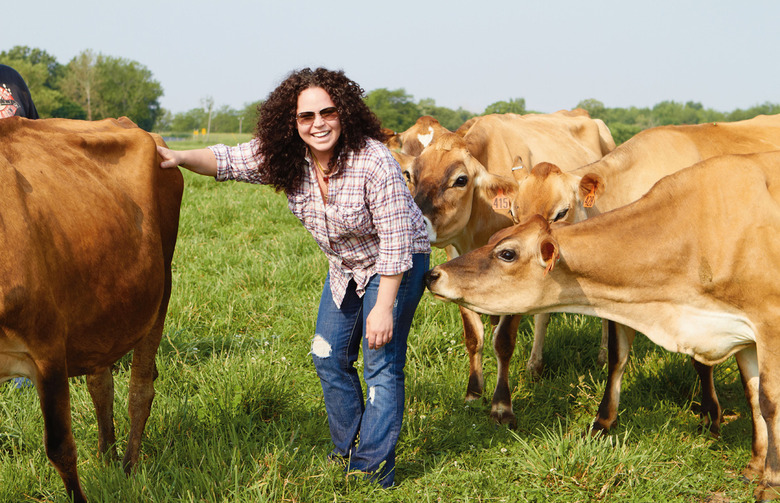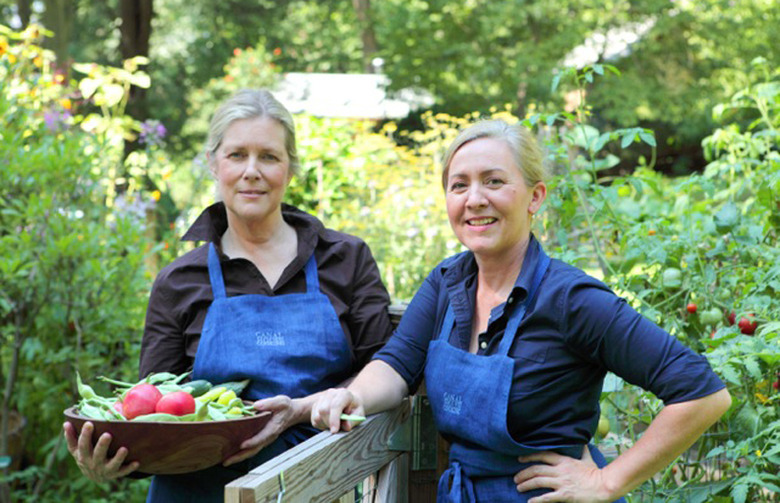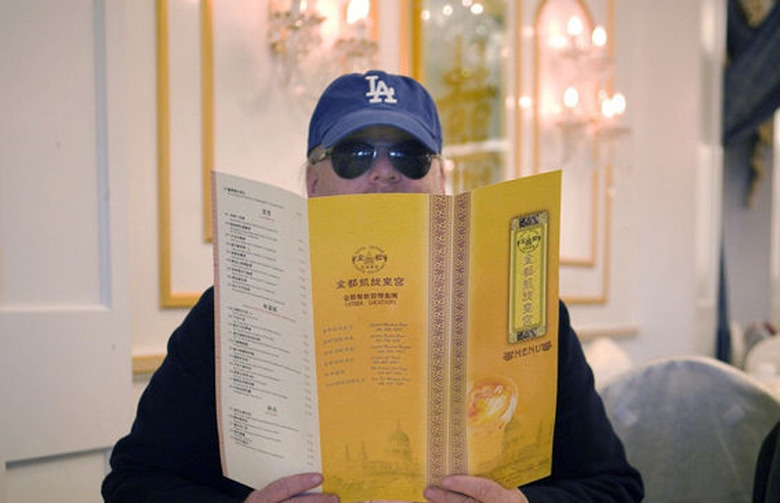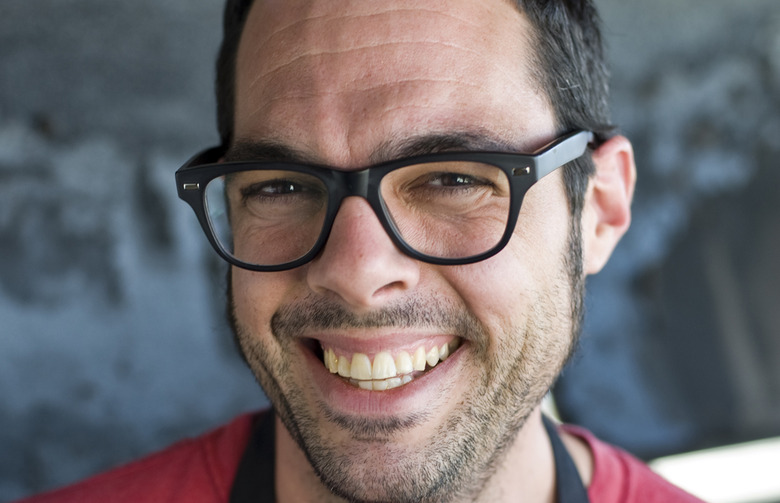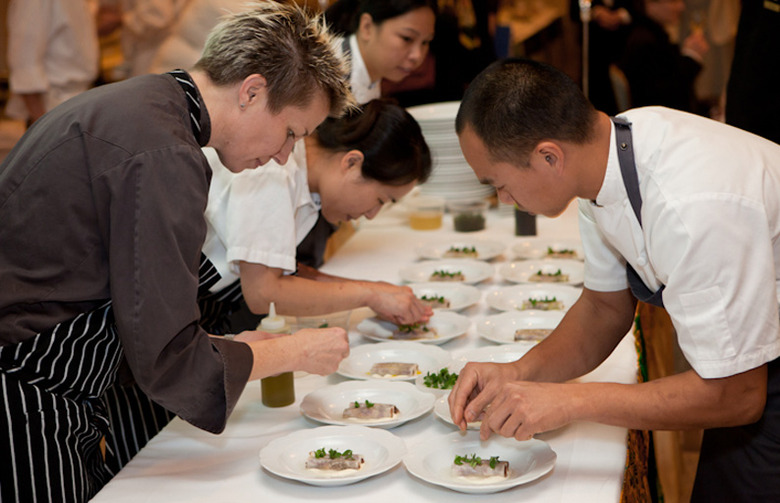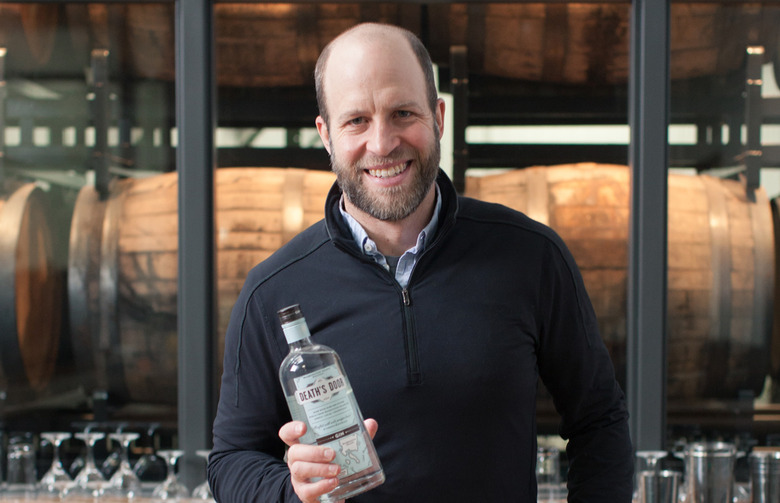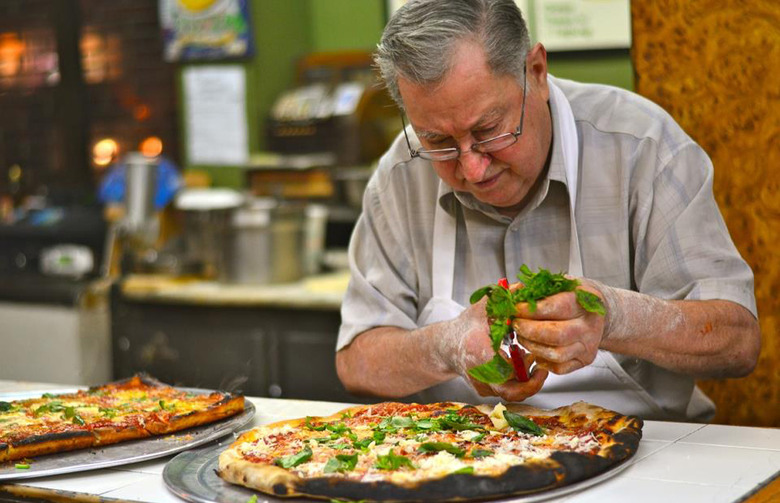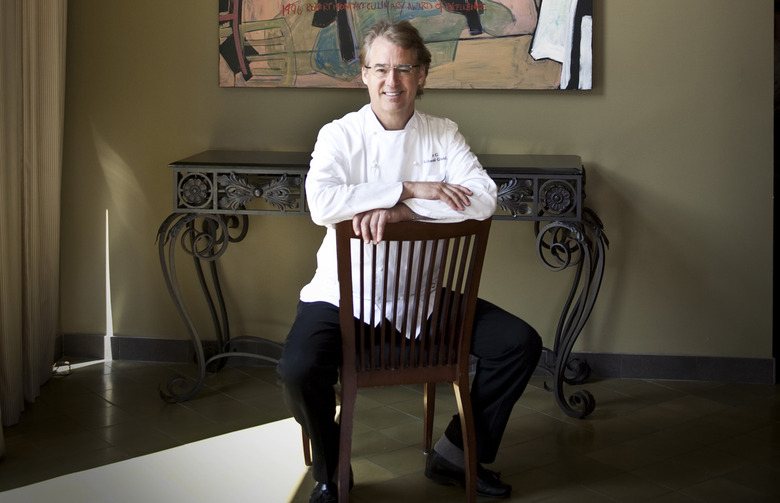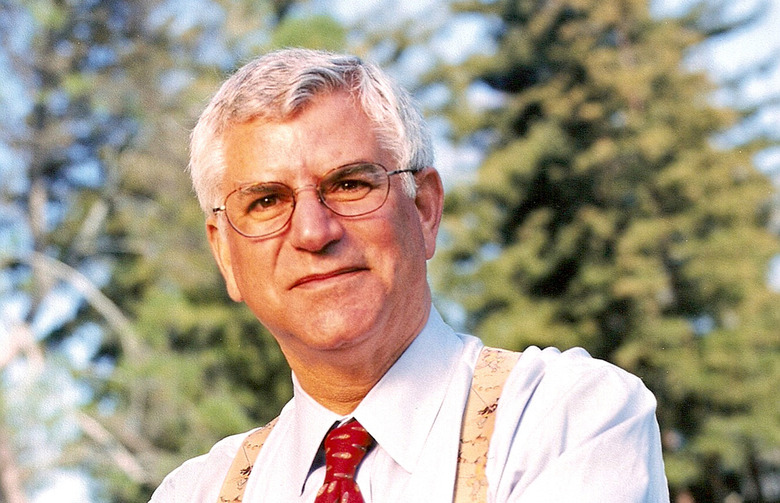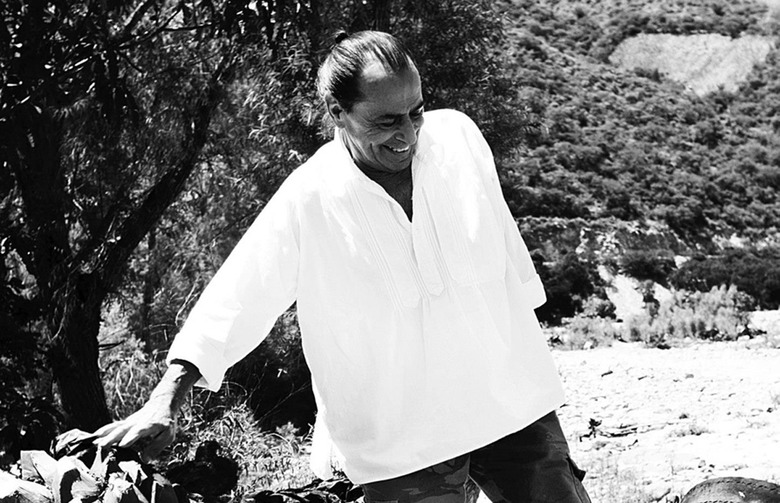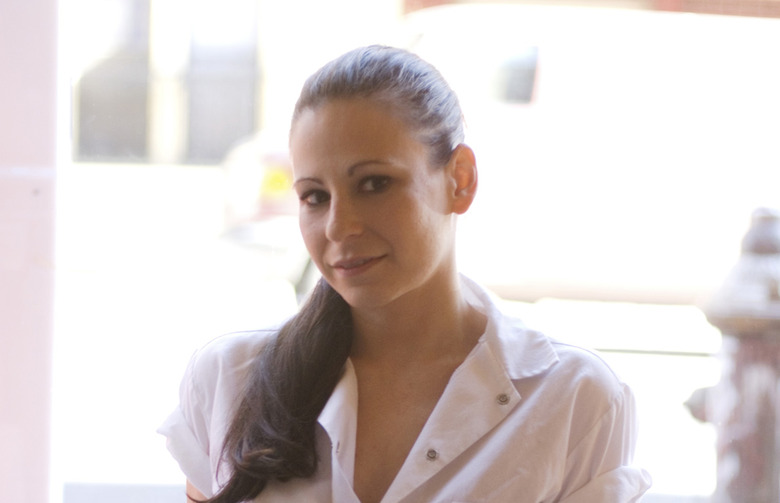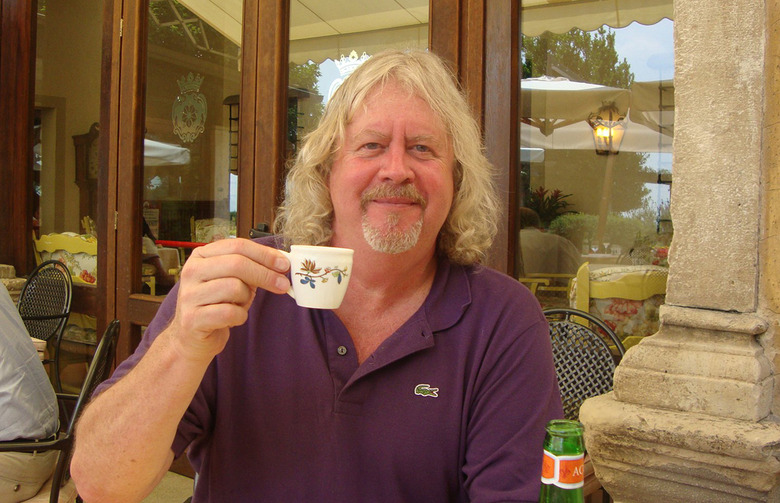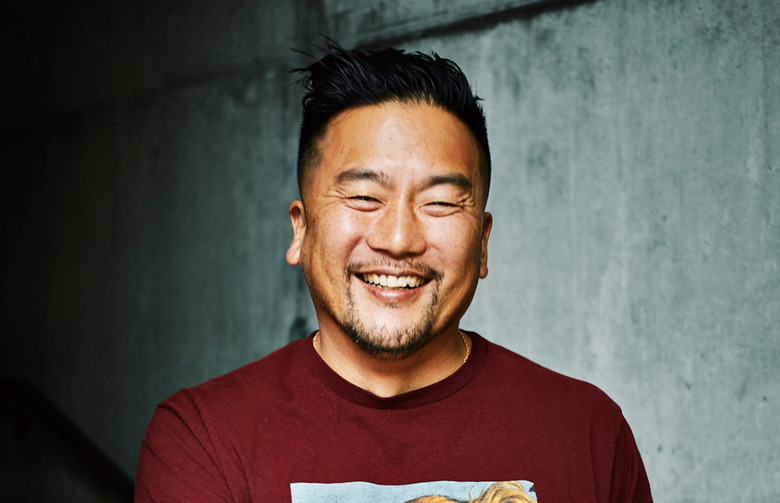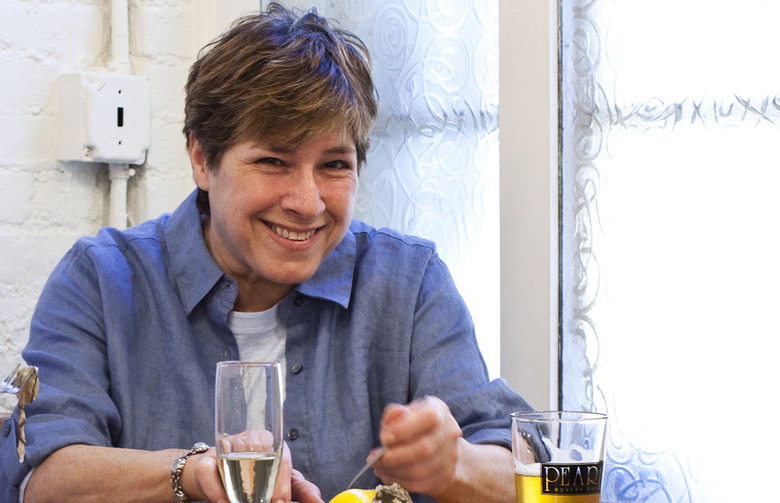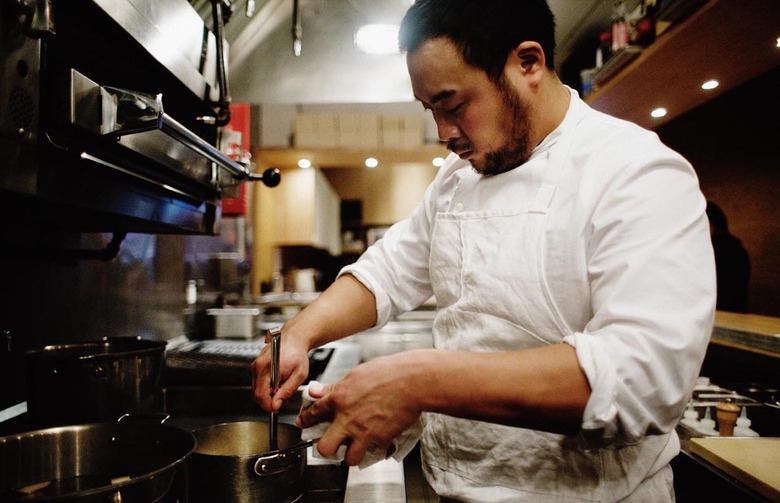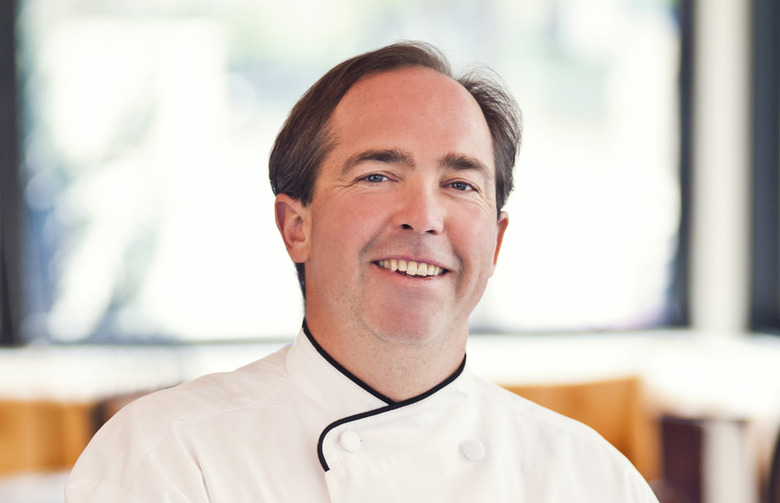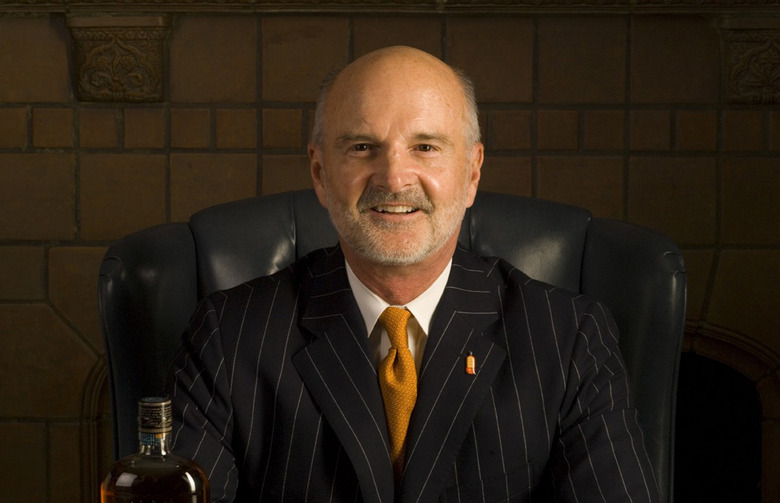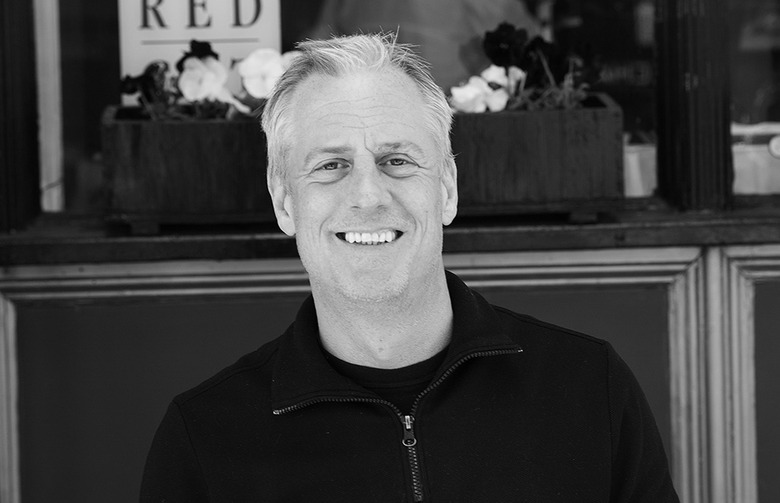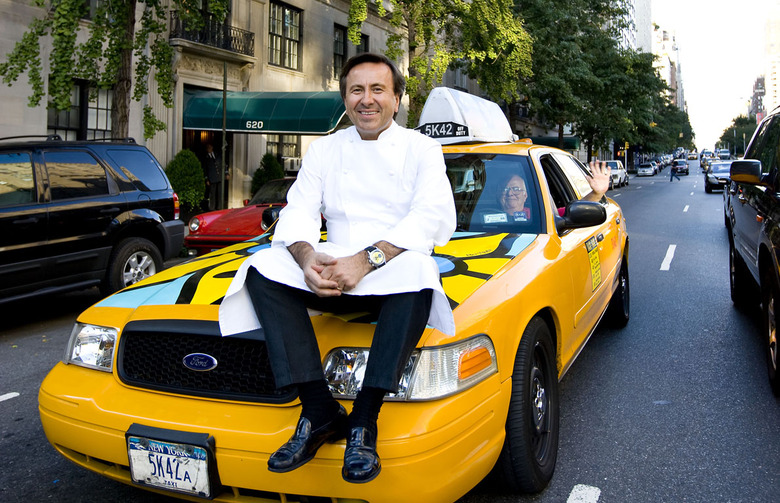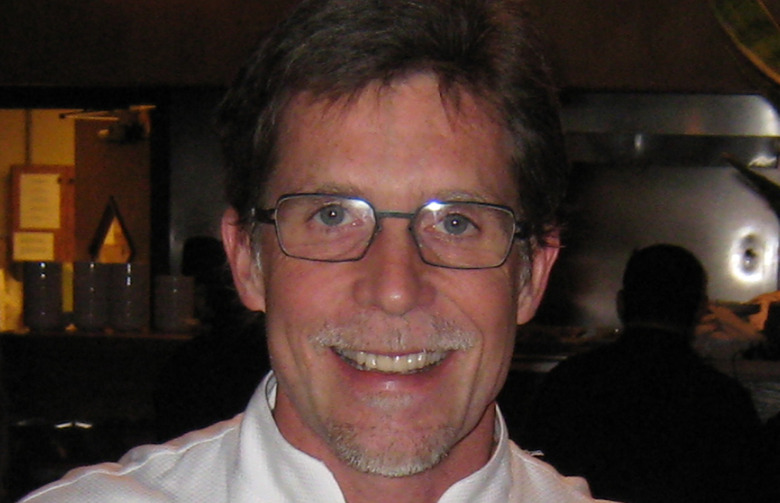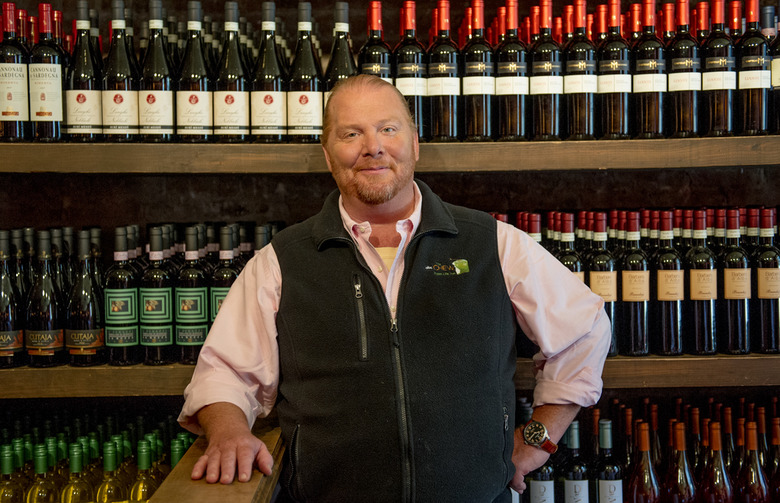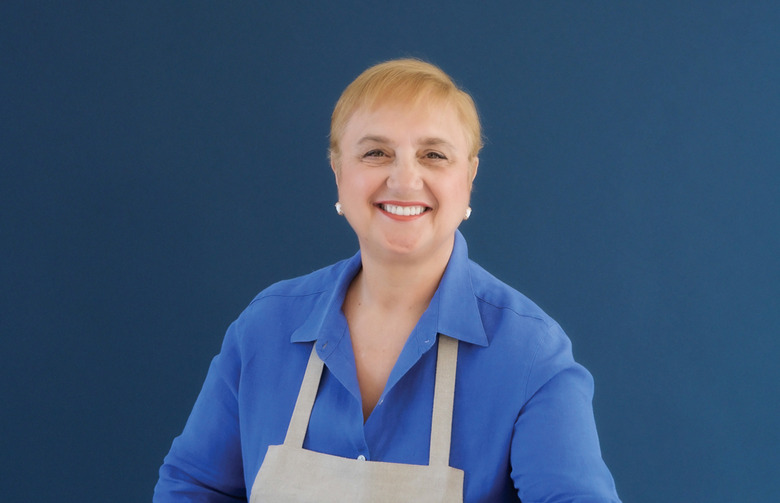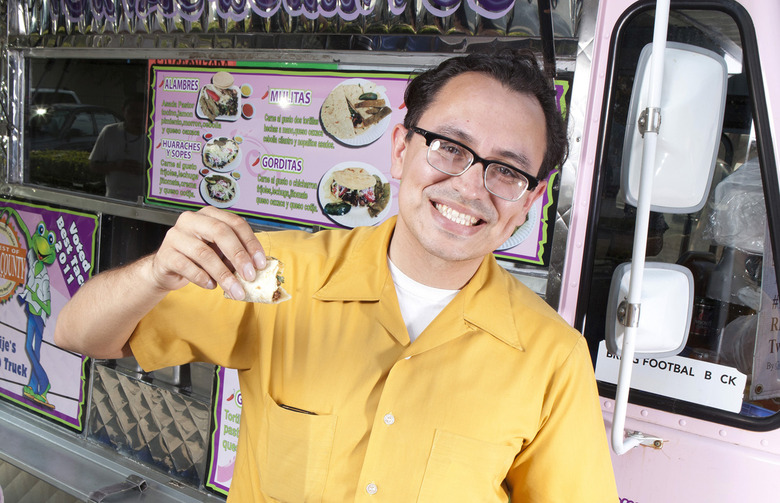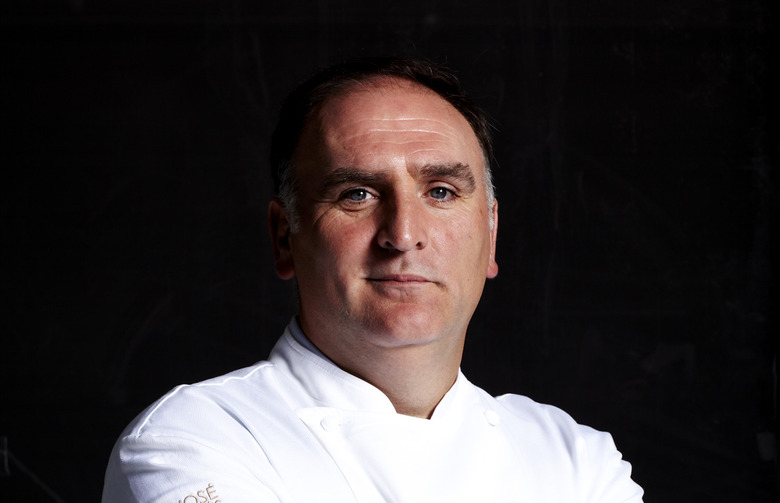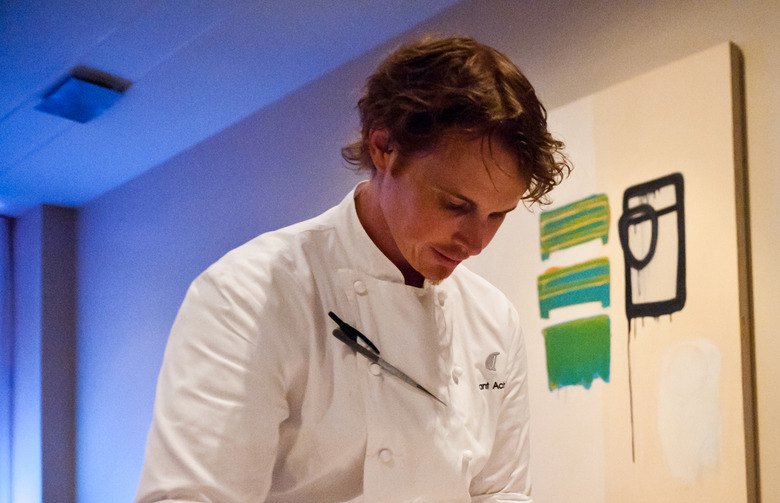The 60 (Plus) Coolest People In Food And Drink
Which one of this diverse collection is the coolest of them all? That's not for us to say. There are no degrees of cool. It's like "unique." You either are or you're not. For that reason, our 60 (plus) Coolest People in Food and Drink are listed alphabetically. Unless you think that "A" is cooler than "W," read no more into our nominees' order of appearance than that.
We know as well as you do, of course, that "cool" is subjective, ephemeral, highly debatable. We're sure you'll disagree with some of our choices, and maybe wonder where your own favorite cool food or drink person is. Let us know. We'll take your input into consideration for next year's list. Oh, and if you're in this business and think you're pretty cool yourself and wonder why you're not on the list, there's a simple answer to that one: If you think you're cool, amigo, you're not.
Andrew Zimmern, Media Personality
As host of the Travel Channel show Bizarre Foods and various spinoffs, Zimmern has visited more than 30 countries around the world and most of the states in America, eating crazy stuff and living a life that many people who are passionate about food and travel would kill for. Despite all that, he remains unexpectedly self-effacing and accessible, and as we learned when we asked him if he shaves his own head, he has a sense of humor about himself, too. (His response: "Well, I used to shave it myself, but now that I'm a big TV star, I have a really young intern who does nothing but travel with me, sees to my bags, and shaves my head. [PAUSE] Of course I shave my own head!") Zimmern is one of those people who is more likely to say nice things about someone else before talking about himself, a quality few of his TV food colleagues are chill enough to emulate. He also rocks the bald look.
David Wondrich, Cocktail Historian
The New York Times dubbed him "a living iPod of drink lore and recipes," while Conan O'Brien once described him as a "crazy, bearded Civil War general." How could you not dig a guy like that? Wondrich is the first person we'd want on our team for cocktail trivia, and also the one we'd trust most to make us a classic cocktail — then tell us its entire history as he worked. Wondrich doesn't just look backward, though. He's a cocktail innovator, too. Consider, for example, the Colbert Bump, created for our favorite recently retired political TV pundit and incipient late-night TV host. It includes Cherry Heering, "good ol' Republican gin," lemon juice, and soda — a real summer cooler.
Carrie Welch
Forget the fact that she pretty much knows everyone in the food world from its celebrity chefs to its behind-the-scenes movers and shakers; that she's just one of those rare, genuine souls that good people flock to; that for a decade as vice president of PR at Food Network, she helped launch some of its most successful shows (and stars) to prominence; or that she left a successful career in New York City to "go West, young woman" with her wife, Jannie Huang, to open a restaurant (Duff Goldman made their wedding cake) in Portland, Oregon, one of the country's coolest cities. Consider that that move spawned a successful restaurant PR firm with a cool name (Little Green Pickle), and that at a time when food festivals seem to be popping up everywhere — and not always to good effect — she has launched, along with co-founder Mike Thelin, one of the coolest food festivals in America: Feast Portland.
Jonathan Waxman, Chef–Restaurateur
Waxman radiates cool. His fellow contestants on Top Chef Masters a while back dubbed him Obi-Wan Kenobi for his Zen-like calm. Tranquilly slicing vegetables and heating up pans while other well-known chefs fretted and scurried, he was the picture of poise and self-possession. Before he became the TV and food festival guest star he is today (besides running his sensuously minimalist Italian joint Barbuto in Manhattan), he cooked at Chez Panisse, brought California cuisine to New York City in the 1970s with Jams, ran one of the best restaurants in the Napa Valley with Alice Waters' ex-husband, and, way back, played trombone in a rock 'n' roll band. Proving that tranquility doesn't squelch creative energy, in the past year, Waxman — a Daily Meal Council member — has opened Adele's and Bajo Sexto taquería in Nashville and Montecito (with partner Ivan Reitman, director of such comedy classics as Animal House, Ghostbusters, and Twins) and is about to launch a twenty-first-century version of Jams at New York City's new 1 Hotel Central Park. Hey, when you're hot, you're cool.
Norman Van Aken, Chef–Restaurateur
First of all, the guy can play blues harp like some ancient Delta dude. What's more, he can cook, and run restaurants. A pioneer of the New American cuisine movement and founding father of New World cooking, with its blend of Caribbean, Latin American, and Southern flavors, Van Aken — a Daily Meal Council member and chef–proprietor of Norman's at the Ritz-Carlton in Orlando — is friendly, intense, and really into what he does, which is orchestrating whole symphonies of flavors in one dish. He also writes cookbooks, thoughtful and amusing essays on food, and lively interviews with fellow chefs (including a number for The Daily Meal, for instance this one with Traci Des Jardins), published a must-read memoir called No Experience Necessary, and hangs out in Key West when he can — and not for the reason presumably inadvertently suggested by his late friend Charlie Trotter when he described Van Aken as "the Walt Whitman of American cuisine." Speaking of Trotter, he is also a mainstay of The Trotter Project, whose stated purpose is to "open doors and inspire minds through the culinary arts" in honor of the late chef.
Christina Tosi, Pastry Chef
The 2012 James Beard Foundation Rising Star Chef was originally hired by David Chang, he noted in the introduction to Tosi's Momofuku Milk Bar Cookbook, "to help us organize our 'office' — a desk in a hallway. [Other sources say Tosi was employed to write a food safety plan for Chang.] Instead, she started organizing the company." Still in her early 30s, Tosi has since built a culinary résumé that rivals those of the most accomplished pastry chefs out there, having worked in the kitchens of Bouley and WD-50 before blowing away fellow cool kid David Chang with her pastry and dessert chops at Momofuku and then its offshoot, Momofuku Milk Bar (now with five locations in Manhattan and Brooklyn and one in Toronto). Tosi's outrageous, ingenious combinations of flavor and texture and confident risk-taking put her in a class of her own. But you can forget all of that — many would argue that Tosi did enough to secure a spot on this list just by creating Crack Pie and Cereal Milk and Cornflake-Marshmallow cookies.
John Thorne, Writer
What makes this meticulous, uncommonly intelligent, reclusive food writer so cool is that he is the opposite of cool as the self-styled cool would define it. He doesn't hobnob or schmooze. You won't see him on Food Network or at star-studded food and wine festivals in Las Vegas or Miami. He's the antithesis of a self-promoter, and always seems vaguely embarrassed when other people try to promote him to the public. His treasured Simple Cooking newsletter and website, which always appeared on a schedule that was erratic to say the least, has just published its first issue in years. All he wants to do is sit in his house in rural Massachusetts with his wife and his collaborator, Matt Lewis, and turn out painstakingly crafted, often grippingly evocative meditations on food and cooking, periodically collecting them in book form. This all may be coming to an end, though. He has announced that issue number 100 of his newsletter will be his last, and has started selling off back issues of the newsletter and a frequently updated selection of the better books, about food and otherwise, that he and his wife have collected over the years. Oh, and about that newsletter: he's only up to number 95 now, and if he keeps going at his customary pace, we might still have him around for a few more years. Which would be very cool.
Dale Talde, Chef–Restaurateur
In 2012, Chicago-born chef Dale Talde, fresh from impressive performances on not one but two seasons of Top Chef, teamed up with restaurateur David Massoni and bartender John Bush to open his first restaurant, Talde, in Park Slope, Brooklyn. A neighborhood gem that's packed every night of the week, it brings in crowds even from far-off Manhattan by the F train-full, helping to boost other local businesses in the process. For his next move, Talde felt the urge to go low-brow, heading over to the other end of the neighborhood to open a roadhouse-style bar, Pork Slope. The cheap drinks, insanely delicious no-frills bar food, and party-like atmosphere draw a slightly different type of crowd, but keep it packed at all hours of the night. Next came the old-style Thistle Hill Tavern, a block from Talde, where the specialties include lobster (not crab) Rangoon, mac and cheese (with four cheeses), Thai mussels, and regular, vegan, and falafel burgers. The trio's latest venture: Talde Jersey City, across two rivers in the Garden State — just the latest proof that this guy is an original.
Michael Symon, Chef–Restaurateur, Media Personality
Philanthropist, TV star, great cook, and all-around nice guy, the bald-pated Symon is a guy who obviously loves his job. The camera seems to love him, as he livens up (but always adds a measure of good sense to) shows ranging from Iron Chef America and Dinner: Impossible to Anthony Bourdain: No Reservations and The Chew. His Cleveland restaurants, including Lola Bistro, Lolita, and the B Spot, have helped make that city a serious food town. He opened a place called Roast in Detroit's Westin Book Cadillac Hotel back in 2008, before it became hip to open good restaurants in Detroit again. He teamed up with Eva Longoria to promote the Lay's potato chip "Do Us a Flavor" competition ("I have very fond memories of eating Lay's chips and onion dip," he told The Daily Meal). Extending his role as culinary ambassador to Midwestern cities not necessarily known for their gastronomic excellence, he went on to open branches of the B Spot elsewhere in Ohio and in Detroit with one on the drawing board for Indianapolis (yes, the specialty at these places in burgers, but Symon, remember, has won the South Beach Wine & Food Festival's high-profile — and highly competitive — Burger Bash four times). Just to keep himself busy, he's also debuting a new Food Network show in mid-July called Burgers, Brew & 'Que. And he always seems to be having a good time doing whatever it is he decides to tackle. That's enough for us.
Frank Stitt, Chef–Restaurateur
When Stitt opened his Highlands Bar & Grill in Birmingham, Alabama, in 1982, "new Southern" cooking hadn't been invented yet. But Stitt saw the similarities and potential happy counterpoints between the cooking of his home territory and that of the Mediterranean region he had come to love (was he the first person to whom it occurred that polenta was basically grits?), and helped develop what has become one of our country's most popular culinary idioms. Speaking of the Mediterranean, inspired by Arrigo Cipriani's approach to Italian cooking, he went on to open Bottega, following that with his state's most authentic French bistro, Chez Fonfon. Stitt is a champion of local ingredients, especially the Gulf seafood caught off the Alabama coast; an influence on many other Southern chefs; and a really nice guy. He pretty much typifies that notion, all too rare among chefs these days, of developing one's own food traditions, learning how to express them very well, and then just keeping one's head down and making diners happy.
Nancy Silverton
She opened one of the definitive LA restaurants of the late twentieth century, Campanile, with her then-husband, Mark Peel, and on the side, oh, just changed the world of bread in America with her next-door La Brea Bakery — which Silverton began as a small artisanal operation in 1989 and sold in 2001 for somewhere around $60 million. She invested her share of the proceeds with a guy named Madoff, and when that went south, what did she do? She joined up with Mario Batali and Joe Bastianich to help re-energize the city's dining scene with the wonderfully original and instantly popular Osteria Mozza (where she makes fresh mozzarella through the evening) and Pizzeria Mozza (there are now outposts of both in Singapore, too, as well as pizzerias in San Diego and Newport Beach). Then came Chi Spacca (Italian for "what splits" — in this context meaning "cleaver"), the kind of place that gives your vegan friends the willies with its menu of things like house-made salumi, lamb neck stracotto, beef and bone marrow pie, pancetta-wrapped sweetbreads, and 50-ounce Florentine-style beef chop. Bread, cheese, and meat. What's not to like?
Lydia Shire, Chef-Restaurateur
Shire is cool and badass. We named her one of our badass woman chefs, in fact, for moves like taking over Boston's venerable Locke-Ober, which had banned women from the dining room for its first century of existence (it's now closed), and for cooking "big" food, full of fat and flavor. Shire, who favors black, pink, or pistachio-green chef's jackets and henna-red hair, got where she is her own way — by hocking her wedding ring to go to cooking school after her first marriage ended and working her way through every good kitchen in Boston before opening Biba there, where she electrified Beantown palates with such fare as fried calf's brains with capers and black gnocchi with squid. Today, she serves great take-no-prisoners food at Boston's Scampo (in the city's old Charles Street jail) and Towne Stove and Spirits.
Rosie Schaap, Columnist, Author
Her father was the legendary sports writer Dick Schaap, and her brother, Jeremy, is an Emmy Award-winning sports journalist. Her cousin is Phil Schaap, one of the most famous jazz disc jockeys and jazz historians. This Schaap's sport, and her art form, too, is cocktails — making them (she is a sometime bartender), writing about them, and enjoying them. Schaap, who writes a regular Drink column for The New York Times Magazine and last year published a memoir (and panegyric on drinking places she has known) called Drinking with Men, is also an ordained minister and former chaplain and the onetime librarian for a paranormal society, and has taught English and managed homeless shelters. With her cascading mane and almost cherubic smile, you'd spot her on a barstool in an instant — and if you were lucky, sidle up beside her for something cool.
Jennifer Rubell, Performance Artist
A graduate of both Harvard University and the Culinary Institute of America, Jennifer Rubell once interned for Mario Batali and has exhibited her provocative art — including a piñata of Andy Warhol's head — in galleries and museums all over the world. What we think is so cool, though, is the way she stages larger-than-life food events, where you can eat the art. In Dallas, she's dripped honey from the ceiling onto a ton (literally) of baby back ribs, and in New York, she padded a room with 1,800 cones of cotton candy. And Rubell's cheese plate doesn't come served cubed or on a cheese board: It consists of elevated, life-sized cheese blocks in the shape of her head, blasted with heat guns, dripping onto stacks of crackers. She has also produced a series of "Drinking Paintings," in which everything from lemonade and Swiss herbal iced tea to dirty martinis and Irish whiskey become her media — with the twist that you can actually drink them all, straight from taps on the canvases. Her art cooks.
Douglas Quint and Bryan Petroff
It was one thing, back in 2009, to meld an ancient American street-food tradition with up-to-date dessert ideas and launch an ice cream truck offering soft-serve ice cream cones with double-entendre names and super-indulgent flavor combinations (for instance, vanilla ice cream, Key lime curd, whipped cream, and crushed graham crackers); it was quite another thing, half a dozen years before the Supreme Court finally did the right thing, to boldly dub it the Big Gay Ice Cream Truck. But that's just what Quint, a classical bassoonist, and his partner (in both senses), Bryan Petroff, did — it was a joke at first, they say, but the name stuck — and the public loved it. Two years later, the two opened their first brick-and-mortar establishment, the Big Gay Ice Cream Shop, in Manhattan's East Village. They upped the ante by developing a new kind of soft-serve in collaboration with Ronnybrook Farm Dairy, and ended up being named the fifth-best ice cream parlor in the world by USA Today. There's now a second Manhattan location and one in Philadelphia, plus a mini-outlet at the Ace Hotel in Los Angeles, with further expansion plans on the menu. Asked by NPR what made the enterprise gay, Quint responded "I make it gay" — adding that if he weren't gay, it would be called that, but also that he wouldn't have used the name if he weren't also gay in the sense of being happy; "It would just be the big crabby ice cream truck," he said. Ice cream is cool by definition; Quint and Petroff make it cooler.
Adam Platt, Restaurant Critic
As the long-time restaurant critic for New York Magazine, Platt is probably one of the most recognized names in the tightly knit circle of major American restaurant critics. Up until a year and a half ago, in fact, he was just a name. Platt made headlines at the end of 2013, though, when he did something that food critics hardly ever do: He took off his mask and revealed his identity as the self-proclaimed "tall, top-heavy gentleman" (complete with photo) behind many of New York's most famous restaurant reviews. As a member of the old guard that ruled before Yelp and bloggers took over, Platt has taken his new lack of anonymity with grace and wit, two characteristics of his writing. And with a Twitter handle like "Plattypants," you know he doesn't take himself too seriously, which is definitely cool in our book.
Jacques Pépin, Chef and Teacher
"Cool? Moi?" That's what we can imagine this venerable but still young-spirited French-born culinary legend saying, to which we can only answer, "Oui, Jacques, vous." What's really cool about this master chef, cookbook author, television personality, and teacher is that he almost certainly doesn't care whether he's cool or not; he just knows that his native cuisine is vitally important to the way we cook and eat today, whether we realize it or not. For decades, Pépin, a member of The Daily Meal Council, has generously shared his knowledge with the world, through books (most recently Jacques Pépin New Complete Techniques), TV shows, and educational programs at places like the International Culinary Center and Boston University. But he's no French snob: He is proud of the fact that his first big cooking job, back in 1961, was developing recipes for Howard Johnson.
Cindy Pawlcyn, Chef–Restaurateur
Pawlcyn worked at a cooking school in her native Minneapolis when she was 13 and ran her own catering business in high school. It's hardly surprising, then, that she was still ahead of the curve when she moved to California, and started doing local and sustainable before a lot of today's local and sustainable apostles could put their Pop-Tarts in the toaster by themselves. She once opened a restaurant in a building shaped like an Airstream trailer (Fog City Diner in San Francisco) and now she owns (among other places) the best restaurant in the Napa Valley that isn't The French Laundry: Mustards Grill, which has been going strong for more than three decades. And speaking of local and sustainable, Pawlcyn also now runs the food service at that beacon of piscatorial sustainability, the Monterey Bay Aquarium.
Enrique Olvera, Chef–Restaurateur
This list of the coolest folks in food and drink is pretty much limited to Americans, not because there aren't enough cool people out there in the world at large but precisely because there are so many of them — we had to draw the line somewhere. We'll keep Enrique Olvera on this side of the line, however. Olvera, whose remarkable Pujol in Mexico City and other restaurants around his native country have made him the most famous chef in Mexico, deserves a place on this list for diving fearlessly into the notoriously competitive and not always hospitable world of New York City fine dining with Cosme. This cliché-shattering place, which opened last year, redefines Mexican food with such dishes as uni tostada with avocado and bone marrow salsa, smoked raw cuttlefish with corn husk oil and salsa Mexicana, and black-garlic-rubbed New York strip steak tacos with shishito peppers and pea-avocado purée. In so doing, it has been a critical and popular success in a market where other international culinary stars (Alain Ducasse, Dani García, Gastón Acurio, et al.) have given up or downscaled. We think Olvera, who fell in love with America after studying at the Culinary Institute of America in Hyde Park, New York, and working at Chicago's elegant Everest, is cool because he's low-key, quirky, passionate about the flavors of Mexico, and at heart just a really good cook — something that frankly can't always be said for our restaurant celebrities.
Michelle Obama, First Lady and Diet Activist
No offense to Dolley Madison, Eleanor Roosevelt, or, well, Hillary, but Michelle Obama has got to be the coolest first lady ever. She looks like an athlete, dresses like a model, tweets more than you do, and actually seems to have our best interests at heart — by planting a White House vegetable garden and writing a book about it, for instance, and espousing the Let's Move! campaign, whose goal is "to raise a healthier generation of kids." As Kathleen Parker wrote in The Washington Post, "She isn't just breaking the mold, she's shattering the good china." Obama has also teamed up with chef Carla Hall on Scholastic's Math @ Work web series, danced funky with a turnip to Lil' Jon's "Turn Down for What?" for a White House Vine (the White House has a Vine account?), did a guest stint as a hypocritical diet scold in a White House Correspondents' Dinner video spoof with Joe Biden and Julia Louis-Dreyfus, and — maybe because she shattered the old stuff? — chose new White House china with a Hawaiian theme. Match that, Dolley.
Niki Nakayama, Chef–Restaurateur
Los Angeles native Nakayama began her culinary career working under renowned chefs Takao Izumida and Morihiro Onodera at Takao Sushi in Brentwood before traveling through Japan to learn both the traditional and innovative techniques of the country's cuisine. Three years later, she returned to her hometown and opened her first restaurant, Azami Sushi, where her omakase menu quickly gained popularity. She then moved on to a second place, Inaka, a take-out spot by day and a restaurant with an eight-course tasting menu by night. In the spring of 2011, Nakayama opened n/naka in Culver City, where she turns out astonishing 13-course kaiseki-inspired tasting menus six nights a week. What makes her so cool, you might ask? Her grit. Throughout the fourth episode of Netflix's acclaimed series Chef's Table, Nakayama details the obstacles she was forced to overcome to open her own successful restaurant: namely, her own family's doubt that stemmed from the traditionally male-subservient role of Japanese women, and restaurant staff, critics, and patrons — both here and in Japan — who were skeptical of how well she could survive, let alone thrive, in a fast-paced restaurant kitchen. As The Wall Street Journal pointed out in a 2014 profile, she may very well be the only woman anywhere in the world serving an avant-garde take on the ancient kaiseki tradition. Nakayama has proven to all the naysayers that she's more than capable of owning and running a unique and successful restaurant, and in our eyes, that makes her one badass chick.
Jeffrey Morgenthaler, Bar Manager and Cocktail Writer
Renowned Oregon-based bar manager Jeffrey Morgenthaler (Clyde Common) was a pioneer in popularizing barrel-aged cocktails — but he doesn't think we should get carried away with them. In a post on his eponymous blog, he once wrote, "Believe me, I'm all for innovation in this little business of ours.... But... I don't think we need to run around barrel-aging every god damn liquid out there..." We think it's cool that he doesn't brag about this claim to fame. We also like the fact that he once wrote a veritable rhapsody about the brandy Old Fashioned. Earlier in his career, after studying Hungarian baroque architecture in Budapest, Morgenthaler tended and managed bars in almost every watering hole in Eugene, with a stint as a researcher for a Fetal Alcohol Syndrome study in between. Last year, he distilled his knowledge into The Bar Book: Elements of Cocktail Technique, written with Martha Holmberg, illustrating bartending basics with recipes for classic cocktails (the martini, the caipirinha, the white lady), and telling us "how ice behaves" and how to infuse dark rum with Chinese five-spice powder. Cross-cultural cocktail cool.
Danny Meyer, Restaurateur
A one-time tour guide in Rome and later field director for Illinois congressman John B. Anderson's 1980 presidential campaign, Meyer went on to work in a New York Italian restaurant, then studied cooking in Italy and France before opening a modest neighborhood place called Union Square Cafe just south of Manhattan's Flatiron District in 1985. In an era when snobby maîtres d'hôtel still ruled in the city, he built the restaurant's reputation on its food, yes, but also on its impeccable service, aimed at giving customers not just dinner but a memorable experience all around. This became an obsession with him — he eventually wrote a book called Setting the Table, outlining his philosophy of hospitality as it applies not just to restaurants but to business and the world in general — and every establishment opened since by his Union Square Hospitality Group upholds the same standards of customer care. Today, Meyer helms more restaurants than we can count, among them such New York City pace-setters as Gramercy Tavern, Maialino, The Modern, and, most notably, Shake Shack — the ever-expanding international burger chain that started life as a pop-up hot-dog cart in Madison Square Park and went public early this year with a valuation of over $1.6 billion. Through it all, the impeccably attired Meyer has stayed cool and kept his sense of humor and of scale.
Jack McGarry, Bar Owner
You could call McGarry a "bartender", but that would be selling him way short. As co-founder and operating partner at the critically acclaimed the Dead Rabbit Grocery and Grog, he has helped transform the nightlife desert of Manhattan's Financial District into "the place to be." McGarry researched and tested literally thousands of ancient cocktail recipes — slings and toddies, horse's necks, flips and follies, and more — adapting them to contemporary palates and thereby helping to animate vintage-cocktail culture in New York City and beyond and inspiring scores of other barmen to look profitably to the past. Named 2013 International Bartender of the Year by Cocktail's Spirited Awards, McGarry may often be found on the second floor of his three-floor old-school Irish bar — which, in addition to its unique cocktail menu, boasts the largest selection of Irish whiskey in New York — chatting with customers in his thick Irish brogue and making cocktails that drinkers would have recognized back before the blight of Prohibition hit our land. Old-school cool.
John Lynch, Soft Drink Maker
Rambling houses in Ireland were private homes where people would meet to drink, play music, and tell stories in towns too small to have a pub. John Lynch's Rambling House, in Columbus, Ohio, is a bit more formal than that — and the animating principle here isn't Guinness or John Jameson but artisanal soft drinks. Lynch was a craft brewer, but one day it occurred to him that it would be very cool if somebody applied the imagination, wit, and skill evinced by America's new crop of brewmasters and distillers to G-rated beverages. The community now flocks to Lynch's place to enjoy all-natural sarsaparilla, ginger beer, cream soda, Columbus cola, and more; to listen to live music ("traditional and roots is the norm," says Lynch's website); and to eat "Jailhouse" pub food with excruciating names — Open & Shut Case'adillas, Billy Club sandwiches, Deputy Dogs for kids — from Columbus's Paddy Wagon food truck. We forgive him the puns. We love the way he's invented his own way of contributing to the American food and drink scene, and built a community around his efforts.
Barbara Lynch, Chef–Restaurateur
A high school dropout from South Boston, one of seven kids raised by a single mother, Lynch discovered cooking in home ec class before leaving school, got her first restaurant job as a teenager, and through talent and hard work, and a stint working for Todd English, ended up as the owner of the Barbara Lynch Gruppo. Under the Gruppo umbrella are two of the highest-rated restaurants in Boston, No. 9 Park and Menton, as well as such popular establishments as B&G Oysters and Sportello. Through it all, Lynch has remembered her roots, and in 2012 established the Barbara Lynch Foundation with the goal of imbuing "urban youth in at-risk Boston communities with the essential life skills to get Up and Out!" Cool-kid chefs on the order of Daniel Boulud (see above) and Michael Tusk have signed on to help.
Alan Kropf, Publisher
As the founder, publisher, and president of the fine beverages magazine Mutineer, Kropf once told us that he fell into the beverage world simply by taking a job as a bartender. Once he realized that he loved wine and spirits, he got certified by the Court of Master Sommeliers and ended up as the sommelier at the London Hotel in Los Angeles and other prestigious establishments. (His Twitter profile quotes Hunter S. Thompson: "When the going gets weird, the weird turn pro.") Flash-forward to today, when Mutineer — which by definition means "one who rebels against authority" — continues to be a leading voice in drink media. "We all wonder why it's so hard to connect with wine culture," Kropf said in a TEDx Napa Valley talk. "There's nothing to connect to with. We've tried to provide the answer key and... help people not screw up when make their buying decisions." When Kropf isn't geeking out at TED, he's heading up Drink Careers 101, an initiative to help millennials find employment in the beverage industry, and serving as Director of Education for the Anchor Distilling Company, which sounds like a particularly cool job.
Kat Kinsman, Writer and Editor
You wouldn't miss Kat Kinsman in a crowd. With her black hair, usually worn either flowing down her shoulders or with shaggy bangs surmounted by a bun the size of a small loaf of artisanal bread, her fire-red lipstick, her striking facial architecture, and above all her supreme if somehow reticent self-confidence, she looks like a film noir villainess — and pretty much commands the room. The editor-in-chief of Tasting Table, and before that managing editor of Eatocracy, she has been an artist (she has an MFA in metalsmithing from SUNY New Paltz and once said "When the apocalypse comes, I can forge weapons and tools for people"), a graphic designer and art director, an ad seller, and the receptionist in a psychiatrist's office. Her writing about food (and other subjects) is witty and savvy. She's working on a book called Hi, Anxiety. Her Twitter handle is @kittenwithawhip. Nuff said?
Thomas Keller, Chef–Restaurateur
Thomas Keller, who is almost certainly the finest American-born chef in the country, is one of those people who seems to have been born knowing what he was supposed to do with his life: cooking. He started as a teenage dishwasher at the Palm Beach Yacht Club and never looked back — and since then he has dedicated his life to learning how to practice his art pretty near flawlessly. His restaurants, from top-of-the-line Per Se and the French Laundry to the family-style Ad Hoc and the several Bouchon Bakery locations, have gotten consistent thumbs up from everyone in the business. That's pretty cool right there. Even cooler, though, is that — ambitious perfectionist though he may be — Keller has also trained and mentored a remarkable progression of up-and-coming culinary stars, who leave his kitchens to go out on their own and achieve success, never forgetting to thank Keller for providing inspiration as a teacher and a friend. When your employees past and present are the ones constantly reminding the public how cool you are, then it must be true.
Lee Jones, Farmer
How many people can get away with wearing a bow tie with overalls? Lee Jones is the only one we can think of offhand. But forget the wardrobe and simply consider what Farmer Lee Jones (as he likes to be called) represents: The Chef's Garden and the associated Culinary Vegetable Institute, a "chefs' haven" which culinary professionals can use for "educational, team-building, and retreat purposes." In the 1980s, after losing a large part of their harvest one year to hailstorms, the Jones family decided to focus on the needs of chefs, developing exceptional specialty and heirloom vegetables, herbs, microgreens, and edible flowers. Many of the big names in the industry today, like Thomas Keller and Daniel Boulud, get their produce from Jones, and he also worked with the late greats Julia Child and Charlie Trotter. Farmer Lee was growing the kinds of produce everybody uses today when most of the folks who use them were mere sprouts themselves.
Stephanie Izard, Chef–Restaurateur
Sure, she has a degree in sociology from the University of Michigan; sure, she was the first female chef to win Top Chef; sure she won a James Beard Award as best chef in the Great Lakes region. She even had the moxie to go up against Ohio superchef Michael Symon on Iron Chef America (she showed well, but he showed better). And she has a dog named Burt. All good things — but the reason we think Izard is so cool is that she celebrates one of the most delicious and protean but (in mainstream U.S. dining, anyway) least appreciated food animals on earth: the rascally goat. At her Chicago restaurant Girl & the Goat, she serves goat in myriad forms (goat empanadas with smoked blueberry tapenade, anyone?) along with such other examples of real if uncommon food as escargot ravioli, duck tongues with tuna and black bean poke, and wood-oven-roasted "pig face." Across the way, at Little Goat, she elevates the diner genre to gastronomy without losing its basic proletarian appeal (here the goat is found primarily in chili for the chili cheese fries). And this summer, she's opening — why not? — a Chinese-inflected restaurant called Duck Duck Goat. The cool part about all this is that she's basically just doing what she wants, and it turns out that we want it too.
Christopher Hirsheimer & Melissa Hamilton, Writers, Photographers, and Cooks
The California-born Hirsheimer (Ms. Hirsheimer, lest the name confuse you) has lived in Northern California, Australia, Hawaii, Illinois, and Pennsylvania, and has been a restaurateur, a corporate chef, a caterer, a food stylist, a magazine editor and co-founder (Saveur), and most of all, a game-changing food photographer, now widely imitated for her accessible, sensuous, natural-looking images. (Look for her work in books by Julia Child and Jacques Pépin, Rick Bayless, Frank Stitt, and Terrance Brennan, among many others.) Her colleague, Melissa Hamilton, a native of New Jersey, once ran the test kitchen at Saveur and before that was the co-founder and executive chef of her father's popular Hamilton's Grill Room in Lambertville, New Jersey. Today, the two (both members of The Daily Meal Council) are redefining cookbook publishing with their unique — and frankly gorgeous — Canal House series of periodical cookbooks, while they create and document wonderful lunches daily (for themselves only, alas) at their New Jersey studio. Each issue of Canal House delves into homey, yet innovative recipes and ideas that make you wish you had thought of baking a chocolate gingerbread cake sooner.
Randall Grahm, Winemaker
Lanky and long-faced, with an abundant ponytail and owlish glasses, Grahm was one of the original "Rhône Rangers" — American vintners who specialize in working with southern French grapes — and may well have coined the term. It's his kind of pun. He bottles wines at his acclaimed Central Coast winery Bonny Doon Vineyards called things like The Heart Has Its Rieslings and Thanks, Semillon (as well as one called I'm Not Drinking Any £#ƒ€!¢ Merlot!) and his book, Been Doon So Long, includes chapters with titles like "Trotanoy's Complaint," "Howlbariño," and "The Love Song of J. Alfred Rootstock." It's not all talk, though: Grahm continues to produce lots of very cool and unusual — and really good — wine, much of it Rhône-inspired. Now he's also making Querry Cider, using four kinds of pears, 10 varieties of apple, and two kinds of quince; if anyone can make cider cool, it's Grahm.
Jonathan Gold, Restaurant Critic
What's cooler than a guy who won a 2007 Pulitzer Prize for his food criticism (to add to his many other honors) but continues to use his influence to shine a light on the small, mom-and-pop "ethnic" restaurants in Los Angeles? If Gold can write a vibrant, captivating column about an outstanding Thai restaurant in a strip mall located in the middle of nowhere — and as a result get throngs of Angelenos to venture there for a meal — that's definitely cool. (Dana Goodyear's piece about Gold in The New Yorker was subtitled "Pig's ear, octopus, and fish-kidney curry with L.A.'s most adventurous eater.") These days, Gold — a member of The Daily Meal Council — plies his trade for the Los Angeles Times. Besides his regular columns for the paper, he produces an annual list of his "101 Best Restaurants" in the LA area, and nobody should be surprised to learn that it ranges from the elegant Providence in first place to the plastic-chopstick pan-Asian "semi-permanent... pop-up" called the Starry Kitchen.
Aaron Franklin, Pitmaster
You don't mess with Texas, and you really don't mess with Texas barbecue. Texas barbecue tradition is full of ancient pitmasters with pits even older than they are. Franklin meets them on their own turf, with a pit that has been in business only since 2011. His Franklin Barbecue in Austin started as a food truck two years earlier, and from the beginning has turned out 'cue so good that you've got to line up early in the morning to have even a chance at sampling it. And in Texas, that's saying something. In fact, Franklin could build bigger pits, quadruple his seating, and hire 20 more assistants and probably make a fortune. He's more interested in making barbecue, though, at his own pace, and he sure hopes you like it. Members of the James Beard Foundation obviously did, voting Franklin Best Chef: Southwest this year — the first time a barbecue chef has ever been so honored, and possibly the last.
Susan Feniger, Chef–Restaurateur
As one of TV's Too Hot Tamales — with longtime colleague Mary Sue Milliken, her collaborator in the Border Grill restaurants in Santa Monica and four other locations (plus a truck), among other enterprises — Feniger has gained renown as an expert on the cuisines of Mexico and Latin America and on international street food (she even opened a restaurant devoted to it, Street, now closed). But she is also an exuberant personality (try to find a photo of her where she's not laughing or at least grinning broadly) with a magnificent mane of hair and lots of earrings, who once revealed that her childhood hero was legendary athlete Jim Thorpe. In 2013, Feniger, a member of The Daily Meal Council, was given the Elizabeth Burns Lifetime Achievement Award from the California Restaurant Association. Late the same year, she opened Mud Hen Tavern — where the menu includes chicken and waffle croquettes and hangover burgers — inspired by her memories of going to minor league Mud Hens baseball games in her native Toledo.
Elizabeth Falkner, Chef and Pastry Chef
From her signature blonde rock star hair to her offhanded ease in any kitchen, whether she's making James Beard award-winning pastries, excelling in the Worldwide Pizza Championships, or challenging Geoffrey Zakarian on The Next Iron Chef, Falkner simply radiates cool. These days, the California native is no longer chained to a restaurant. She's writing a memoir, working on some food installations (she's an artist as well as a chef), developing a project she calls Fit To Cook and Warrior Wellness (which she describes as "speaking, warrior work-outs, and cooking and eating with groups of people"), serving on the president's committee of Women Chefs and Restaurateurs, and cooking at food festivals and charity events all over the place — doubtless doing it all with her usual calm efficiency.
Brian Ellison, Distiller
The American landscape is filling up with artisanal distilleries — not that that's a bad thing. There are just so many of them, seemingly at least one in every state in the union and many in some states (and some cities; wassup, Brooklyn?). What, then, makes Brian Ellison, president and CEO of Death's Door Spirits, something special? Let's start with how his company got started: Ellison worked in land planning and economic development in Madison, Wisconsin, and took up the cause of supporting small- and medium-size family farms in the region. He eventually focused on Wisconsin's 22-square-mile Washington Island, once known for its potato fields but then lying fallow. In 2005, brothers Tom and Ken Koyen planted five acres of wheat on the island, originally meant for flour. It soon found a market, though, as base material for ale produced by the island's Capital Brewery and for all of Death's Door's spirits — first-rate, character-filled vodka, gin, and "white" whisky. Ellison and his crew now produce more than 250,000 cases annually of these products, and are supporting efforts to expand those five acres of wheat to 1,200 acres. We love the idea of distilling with a purpose. We also like the name Death's Door — a reference to the passage between Washington Island and the mainland.
John T. Edge, Writer
For starters, Edge looks cool: He was wearing thick-rimmed glasses long before every hipster in America started sporting a pair, and his signature soul patch actually somehow lends him soul. Not that he wouldn't have it anyway. As an author of books dedicated to (among other things) fried chicken, apple pie, burgers, and the food truck culture; director of the Southern Foodways Alliance (which studies, promotes, and preserves the kind of food we all want to eat); contributor to The New York Times, Oxford American, and Garden & Gun; and frequent and entertaining tweeter extraordinaire, Edge is an American culinary treasure. This Daily Meal Council member continues to champion the best food that the American South has to offer, and just knows a whole lot about food in general. If you let him, Edge will utterly school you on why Southern food matters: "Our beloved provincial dishes serve as unifying totems of people and place." See? Cool.
Dom DeMarco Sr., Pizzaiolo
Dom DeMarco is beyond cool; when it comes to New York City pizza, he's a legend. Arriving in New York City from Caserta, near Naples (the birthplace of pizza), in 1959, he opened Di Fara Pizza on Avenue J in Brooklyn and has been doing it his way, pie by pie, ever since. The pizzas — stretched-out dough, ladled sauce, sprinkled cheese, a drizzle of oil, scissor clippings of fresh basil — are all lovingly prepared by DeMarco himself, how and when he wants. Then they're ravenously consumed by lines of both locals and tourists in the know. As far as pizza-savvy New Yorkers are concerned, if you haven't braved the masses to enjoy a Di Fara pie, you don't know pizza at all.
Robert Del Grande, Chef–Restaurateur
A onetime California biochemist, the wry, soft-spoken Del Grande, a member of The Daily Meal Council, moved to Texas more than two decades ago and turned himself into one of the best and smartest "new Southwestern" chefs, galvanizing the Houston dining scene with his Café Annie and the lamented Taco Milagro. Today, Café Annie has morphed into the buzzy RDG + Bar Annie, and Del Grande also oversees two restaurants at Discovery Green, Houston's downtown "signature" park, The Lakehouse and The Grove. Along the way, he started playing guitar and singing with Dallas chef Dean Fearing and a changing cast of other colleagues, at first casually in hotel rooms and later with their band, The Barbwires, sharing the stage with people like Steve Winwood, Rodney Crowell, and Richie Furay. When legendary rock bassist Jack Bruce (Cream) died last fall, says Del Grande, "I (somehow) felt obliged or inspired to play the bass," which led to an attempt to interpret the Bach cello suites on the instrument. Returning to his scientific roots, Del Grande also concocted, last year, the first-ever Texas-made gin, called Roxor and flavored with Texan botanicals. The project ran aground — "Making gin is like guitar playing," says Del Grande. "It's tough to get all the strings in tune at once" — but he plans to relaunch it this year.
Camas Davis, Writer and Meat Specialist
It's all about the meat. Davis was the research editor at Saveur, and then went off to Portland, Oregon, as managing editor and food editor at Portland Monthly. Somewhere along the line, she decided that she wanted to learn the butcher's craft, so she did an apprenticeship at a butcher shop and charcuterie in France. Back in Portland, she hoped to pursue her studies of the skill, but couldn't find a place to do it — so she launched a butchery school of her own, the Portland Meat Collective, drawing some of the region's best chefs and butchers in to teach classes. Soon, she was skilled enough to start teaching classes herself. Today, the PMC tutors students in such subjects as basic beef butchery, sausage making, and basic rabbit butchery and charcuterie, and Davis, part of The Daily Meal Council, takes her message of cutting what you're going to chew even into local schools. If you've seen Davis in those Wusthof knife ads, you know that she can handle a blade with real savoir-faire.
Darrell Corti, Grocer
One sign of how cool this Italian-American Sacramento grocer is is the fact that he'll think the whole idea of being considered cool is just plain silly. Running the family business in the California capital is a full-time job, and he doesn't have spare moments for a lot of folderol. Of course, Corti is a grocer like Itzhak Perlman plays some fiddle. Corti is simply one of the most deeply knowledgeable food and drink experts in America, able to expound with equal authority on Chinese tea, Spanish vinegar, Central Asian wine, Italian pasta, and about 30,000 other gastronomic topics. The Corti Brothers online store, where you can buy their Italian specialties even if you don't live in Sacramento, remains charmingly low-tech and straightforward, giving away very little about the vast treasures and culinary knowledge amassed by this family. At the store itself, you can shop for everything from toilet paper and skim milk to artisanal soy sauce and sherries so rare you can't even find them in Spain — or just stand in line for one of the California capital's best deli sandwiches. Corti, a member of The Daily Meal Council, knows everybody worth knowing in his chosen field, and everybody knows him. They call him "The Professor." If you've never heard of him, well, that sort of makes him even cooler, you know?
Ron Cooper, Mezcal Importer
Cooper's light sculptures and other environmental installations are in the permanent collections at New York's Guggenheim Museum and the Los Angeles County Museum of Art — but after he discovered true artisanal mezcals in the Oaxaca countryside in 1990, he saw a different kind of light and made it his mission to bring these unique and powerful spirits to an American audience. The label he founded, Del Maguey, doesn't traffic in those mild, anonymous mezcals that are trying to be tequila; these bottlings, with unique and instantly recognizable labels by the late ceramic artist Ken Price, are produced in tiny villages, down dirt roads, absolutely by hand, from agave hearts roasted in stone pits and ground in horse-powered mills, and they're full-bodied, often smoky, and flavorful as hell. Some of his mezcals are made from rare wild agave varieties — and his Santa Catarina Minas Pechuga undergoes a third distillation with wild mountain plums and apples, red plantains, pineapples, almonds, and raw rice added to the mix, with the vapor condensed over a raw chicken breast (pechuga) said to mitigate the sweetness! To help ensure that such traditional treasures won't be lost, the affable Cooper has even founded a nonprofit organization with a name almost as mouth-filling as Del Maguey's products: the Foundation for the Sustainable Development of the Producing Communities of Maguey and Cultural Rescue of Mezcal.
Amanda Cohen, Chef–Restaurateur
The fact that Amanda Cohen owns an entirely vegetarian restaurant is cool in itself, but what's even better is that it's really good. Embracing "haute vegetable cuisine," Cohen is keen on the dining experience and created Dirt Candy — which recently moved into new, larger quarters — with the idea that guests at the restaurant should feel like they're in the comfort of her own kitchen. She's also penned a comic book-like cookbook, making hers stand out among the plethora of vegetable-based cookbooks out there and adding a bit of life to the cooking experience. Cohen doesn't hide her opinions under a cabbage leaf, either. A couple of years ago, she called out Time Magazine for not including any goddesses in their "Gods of Food" issue; more recently, she began a semi-regular column for Eater.com, in one of which she asked "How soon is too soon to review [a restaurant]?" No one is more critical of Dirt Candy than she is, she wrote. A restaurant is never finished — "But at a certain point, you've got to let it go." Cool.
Jim Clendenen, Winemaker
He has been described as looking like the drummer in a Southern jam band, has made wines inspired by Mexican wrestlers and Italian porn stars (and more recently, his family dog), and owns more Hawaiian shirts than Don Ho. More to the point, through his Santa Maria-based Au Bon Climat winery and related enterprises, Clendenen is as responsible as anyone for earning Santa Barbara County its reputation as the source of some of the best wines in America — and his chardonnays and pinot noirs are good enough to make producers in his beloved Burgundy more than a little nervous. (His pinot blancs and pinot gris aren't bad either, and he's had increasing success with Italian varietals as a side project.) Just to seal the deal, Clendenen is also known as one of the best cooks in the winemaking community.
Roy Choi, Chef–Restaurateur
It's somehow fitting that while Virginia-born, New York-based Korean-American chef David Chang (see above) sparked a restaurant revolution when he opened his first Momofuku Noodle Bar in a hole-in-the-wall in Manhattan's East Village, Seoul-born, Los Angeles-based Korean-American chef Roy Choi sparked his California-style — on wheels. His Kogi BBQ Taco food truck, which he launched in 2008 in partnership with Mark Manguera and Caroline Shin-Manguera, broke ground while covering ground, serving bold Mexican-Asian hybrids like kimchi or sweet chili chicken quesadillas, tofu tacos, and spicy pork burritos in locations around LA, revealed to hungry Angelenos via social media. His fleet eventually expanded to five trucks, and Choi was named one of Food and Wine magazine's Best New Chefs of 2010 — a first for a food-trucker. Not that he stayed just a food-trucker for long. Today, Choi has two restaurants, POT and Commissary, in Koreatown's Line Hotel and a stationary food truck in a terminal at Los Angeles International Airport, plus a new Caribbean-themed place called Sunny Spot in Venice. He is also collaborating with esteemed San Francisco chef Daniel Patterson (Coi) on the first unit of what they hope will be a large chain of high-quality fast food restaurants called LocoL, expected to open in San Francisco's Tenderloin district this fall. In his spare time, he consulted with Jon Favreau on Chef, kicked off a CNN series called Street Food, and tantalized us by hinting that he might open something in New York City one of these days — all without going corporate or losing his stoner cred. Our kind of trucker.
Rebecca Charles, Chef–Restaurateur
It's hard to believe now, but in 1997, when Rebecca Charles opened Pearl Oyster Bar in New York's West Village, there was not a lobster roll to be found in Manhattan. Whether others imitated her or were inspired by her success, it would be hard to argue that Charles didn't launch, or at least help launch, this humble yet decadent sandwich to national prominence. With a tip of the toque to San Francisco's classic Swan Oyster Depot, Charles' inspiration came from summers spent on Gooch's Beach in Kennebunkport, Maine, and her idea was to elevate the region's classic foods, but maintain their simple elegance. Pearl (one of America's best oyster bars) has been a raging success. If making the best lobster roll outside Maine isn't cool enough, consider that its success started in the late 1990s, when you could count on a few fingers the number of female head chefs in New York City; recall her refusal to sit back and just take it when one of her cooks left to open his own place with what she believed to be her recipes (that story landed on the first page of The New York Times); or just watch her work the pass and drop 23 lobster rolls on tables at the same time before sipping on her post-shift cornichon martini. Cool.
David Chang, Chef–Restaurateur
Sure, there's the hype and the attitude, the highly unconventional food magazine (Lucky Peach), the ever-growing empire, the pork buns, the ramen, the fried chicken two ways (plus the fried chicken sandwich at his new Fuku, which already has lines around the block), the aesthetic, the online reservation systems for special meals, the attention to detail (service and otherwise), and the fact that Chang showed a generation of chefs that you could open up a new class of quality-dining restaurants without the white tablecloths. There's the showcase (or, rather, showcases — there are now six of them) he gave to Christine Tosi (see below) at Momofuku Milk Bar, where she became the most talked-about dessert chef in America. There's the fact that Time Magazine named him one of the "100 Most Influential People" in the world in 2010, and that the James Beard Foundation inducted Chang into the Who's Who of Food and Beverage in America. There's the success with which he has expanded to, and galvanized the restaurant scenes in, Sydney and Toronto. But most of all, there's the core coolness that started it all, the fact that with his first restaurant, Momofuku Noodle Bar, he put it all on the line — all that pork, all that soul — and success or failure, he was going to do it the way he was going to do it, vegetarians be damned, and he did.
Walter Bundy, Chef
Unless you live in or near Richmond, Virginia, you've probably never heard of Walter Bundy, the longtime executive chef at Lemaire, the restaurant at that city's Jefferson Hotel. He isn't one of your big-name Southern chefs, a Sean Brock or a Frank Stitt or a Linton Hopkins (though Brock honed his craft as Bundy's sous chef for a couple of years), but he represents the Southern culinary spirit, and celebrates the bounty of his own corner of the South as well as anyone we can think of. "People don't want tasting menus," he once said. "They want a white-tablecloth dining experience without the pretense. They want better food from around their area." That's what Bundy — whose résumé includes stints at Mark Miller's Coyote Cafe in Santa Fe and Joachim Splichal's now-closed Napa Valley outpost Pinot Blanc, and then under Thomas Keller at the French Laundry — gives them, with his chicken-fried Chesapeake Bay oysters, his garlic-crusted Outer Banks mahi-mahi, his coffee- and brown-sugar-glazed pork loin chop with Anson Mills polenta and slab bacon, and the like, all of it superb. We like the fact that he doesn't spend more time on TV sets than in the kitchen and isn't building empires; he's just cooking really well, "as locally as possible" — right down to the parking-lot (not rooftop) garden, full of tomatoes and other vegetables he grows just because he likes to.
Tom Bulleit, Whiskey Distiller
What a story this guy's life makes: He grew up working in a distillery, went into the military, earned a law degree on the GI Bill, practiced law for 30 years, and then decided to go into the bourbon business, following in the footsteps of his great-great-grandfather, who first made whiskey around 1830. Then he managed to smooth talk Seagram's into buying Bulleit (it's now under the Diageo umbrella), while staying involved by jet-setting across the country to promote the product that bears his family's name. Which means a) he's been everywhere, and b) he knows everyone. The original Bulleit recipe was unusually high in rye, so it's not surprising that there's now a Bulleit rye as well — though neither it nor Bulleit bourbon (which itself is made from roughly one-third rye) are now actually distilled by the company itself currently (Diageo will resume production in 2016 at a distillery now being built). It's still great stuff, though. And Bulleit is basically your charming grandfather who knows all the good stories to tell and says things like, "the Facebook." Except that he also knows how to sell a kickass batch of whiskey.
Jimmy Bradley, Chef–Restaurateur
He walks cool, he talks cool, he cooks cool. His restaurant the Red Cat, in New York City's artsy Chelsea quarter, has been the definitive hip neighborhood restaurant since 1999, appreciated equally for its tempura green beans, its squid ink tagliatelle, and its grilled heritage pork with crispy white polenta and Calabrian tomato sauce (there are definite Italian accents to Bradley's American market menu). His other notable establishment, The Harrison, was the first restaurant to open in Tribeca after 9/11 and helped reinvigorate that mortally damaged corner of Manhattan (it closed late last year). He has a consulting firm and has been seen on food TV in various contexts, but he doesn't make a big deal about it. He's just a guy who likes to cook. And that's enough.
Daniel Boulud, Chef–Restaurateur
Daniel Boulud was cooking French when cooking French wasn't cool. It certainly seems to be cool again these days, with old-style bistros opening in New York City and elsewhere at a heartening pace — and we can't help thinking that this amiable Daily Meal Council member had at least something to do with our rediscovery of the virtues of la cuisine française simply by keeping the faith. His eponymous Daniel, which opened originally in 1993, has remained a temple of fine French cooking, its reputation and quality untarnished even when the Guide Michelin and The New York Times both inexplicably demoted it by one star. (On the other hand, it took first place in our 101 Best Restaurants in America this year.) He has also showed us the casual, fun side of Gallic gastronomy, inventing the much-copied foie gras burger at his DB Bistro Moderne and proudly serving some of Manhattan's best sausages, in glorious variety, at his DBGB Kitchen and Bar — named in honor of the lamented punk venue CBGB, which was just a few doors down.
John Besh, Chef–Restaurateur
Even if John Besh didn't run 10 terrific restaurants, mostly in New Orleans — including an Israeli-accented place called Shaya, with chef Alon Shaya, and two branches (one in Baltimore) of a collaboration with Aarón Sánchez called Johnny Sánchez, plus an 11th (Willa Jean Bakery) about to open — he'd still be a key player in the Southern food scene through his John Besh Foundation. Founded in 2011, this organization is dedicated to helping to protect and preserve New Orleans foodways through programs like Chefs Move! (a culinary scholarship fund) and Milk Money (offering micro-loans to area farmers). He also hosts Hungry Investors on the Spike network, traveling the U.S. with two colleagues, helping promising but troubled restaurants meet their potential — more Kitchen Dreams than Kitchen Nightmares. Besh is known for putting his heart and soul into everything he does and for doing everything with that friendly Southern Louisiana smile.
Rick Bayless, Chef–Restaurateur
Longevity is not a given in food TV (haven't seen you on the screen in a while, Rocco), but Oklahoma-born Rick Bayless's Mexico: One Plate at a Time, a cooking show on PBS, is now in its 10th season and shows no sign of stopping. Bayless, a Daily Meal Council member, has spent most of his career researching and sharing his knowledge of the culinary landscape of Mexico, through that and other TV shows, numerous cookbooks, and 11 restaurants and upscale fast-food outlets in Chicago and vicinity (including three at O'Hare International Airport) and one in Philadelphia. His Chicago flagships, Frontera Grill and the adjacent Topolobampo, the latter being one of America's first fine-dining Mexican restaurants, are always on everybody's "best" lists. Bayless is also active in food politics: He was a founder of the Chefs Collaborative (which educates chefs about sustainable practices), is active in Share Our Strength (whose No Kid Hungry initiative brought top chefs and wineries together in New York City last spring), and has his own Frontera Farmer Foundation to support Chicago-area farmers. The coolest thing about this talented chef–restaurateur, though, is that a few years back, he and two collaborators wrote and produced, and Bayless starred in, the well-reviewed Cascabel: Dinner — Daring — Desire, the story of a meal with song, dance, and physical feats, at Chicago's Lookingglass Theatre. Apparently, Bayless can really cut a rug.
Mario Batali, Chef–Restaurateur
We were thrilled in April when we heard that Batali, a member of The Daily Meal Council, was opening a meat-centric restaurant in the Azores with Italian celebrity butcher Dario Cecchini, then heartbroken when we learned that the news was just a joke — but we salute this ebullient celebrity chef for plenty of other things. He turned orange Crocs into a fashion statement. He hams it up with Jimmy Fallon. He traveled through Spain in a convertible with Gwyneth Paltrow, is opening super high-end Italian megastores right and left, and plays everything from Led Zeppelin to Neutral Milk Hotel — loud — at his flagship Babbo (a fact which apparently made former New York Times restaurant critic Frank Bruni quiver). Batali gets extra points for being responsive on Twitter, for owning the first Italian restaurant in 36 years to boast four stars from The New York Times (Del Posto), for hosting a digital series called Feedback Kitchen for which he interviews famous musicians (Patti Smith, Flea, Josh Groban) and then cooks for them, and for remaining an unreconstructed party animal through it all.
Lidia Bastianich, Chef–Restaurateur
Born on the Istrian Peninsula, then part of Italy but now belonging to Croatia, Bastianich learned about food literally from the ground up, on her grandparents' farm; they grew, raised, produced, vinified, and milled everything they could, and bartered their produce for the rest. Bastianich was right there with them, pitching in. She immigrated to the United States at the age of 12, and got her first food-related job at a bakery near her family's apartment in Astoria, Queens. Years later, in 1971, she opened a restaurant in Forest Hills with her husband, Felice Bastianich. A decade after that, the Bastianichs launched Felidia in Manhattan. With her children, Joe and Tanya, and longtime Bastianich associate Mario Batali (see above), Bastianich currently co-owns numerous restaurants, including Felidia, Becco, Esca, and Del Posto, all in New York City, and has a hand in the Eataly outposts in New York and elsewhere. Together with Tanya, she also runs a food product line and a television production company, has starred in the three-time Emmy-nominated television series, and has written numerous accessible, mouthwatering books. She is one of the most influential Italian culinary personalities in the country, but doesn't brag about it, which is cool; she is also most probably the only person who can talk back to her "restaurant man" son, Joe.
Gustavo Arellano, Writer and Editor
Why do Mexicans love clowns? Why do white people get mad that Mexicans hate Marco Rubio? Why aren't corn tortillas as big as flour tortillas? Want to know the answers to these questions and just about anything else you can think of that has anything to do with citizens of that country south of our border or their descendants? ¡Ask a Mexican! Not just any Mexican, but Gustavo Arellano, who responds to any pertinent question (and lots of impertinent ones) in his nationally syndicated column of that name, with humor that always has a bite. Arellano is the editor of OC Weekly, a lively alternative newspaper and website in conservative Orange County, California, and a lecturer in Chicana and Chicano Studies at California State University Fullerton. He is also a food lover, who records his 100 favorite dishes every year (the list for 2015 so far includes the quattro formaggi panini from Old Vine Café in Costa Mesa and the pancake sandwich at Willowick Golf Course in Santa Ana), and is the author of the pretty much definitive Taco USA: How Mexican Food Conquered America, which is about exactly what it sounds like. We like his attitude, cool but just a little edgy. Oh, and that thing somebody asked a Mexican about? "[F]lour tortillas can get bigger because of their gluten, of which corn tortillas have next-to-none."
José Andrés, Chef–Restaurateur
José Andrés pretty much is Spanish food in America — avant-garde and traditional both. From his original Jaleo in Washington, D.C., to his Bazaars in Los Angeles, Miami, and Las Vegas (the last of these the dazzling Bazaar Meat), his chefs serve up food that is unfailingly full of flavor and full of verve. Meanwhile, Andrés himself seems to be everywhere, not just checking in with all his restaurants but flying down to Haiti to strategize about his plan for giving impoverished families clean-cooking parabolic solar ovens; settling down to tortillitas de camarón at his favorite seafood restaurant in Cádiz; headlining at the TED-inspired Bite SV conference in Silicon Valley; tackling issues like the minimum wage, the Farm Bill, and immigration reform at the International Association of Culinary Professionals conclave; even opening the first of what he hopes are many iterations of Beefsteak, a fast-food concept in which meat plays only a minor role... Whatever this peripatetic Daily Meal Council member does, we know it will be exciting. We don't know how he does it. Well, actually, we do: He's passionate and irrepressible, and he has a sense of humor. Él es guay.
Grant Achatz, Chef–Restaurateur
Achatz's culinary pedigree includes stints with Charlie Trotter (briefly), Thomas Keller, and Ferran Adrià (briefly but life-changingly). He went on to be named a James Beard Rising Star Chef at the now-defunct Trio (making the Chicago suburb of Evanston a must-visit destination for anybody serious about dining), and then opened his own Alinea, where course after dazzling, perception-challenging course forged a distinctly American identity for what nobody really ought to call "molecular gastronomy." With his second restaurant, Next, Achatz invented something new: a restaurant that changes concepts every few months — and, incidentally, that introduced the ticketing concept to restaurant reservations. Along the way he toughed it out to beat Stage IVB tongue cancer, a battle he chronicled in his best-selling memoir Life, On the Line, co-written with his business partner, Nick Kokonas. Oh, and on the side, he has created one of the most original cocktail bars in America: The Aviary, which is cooler than the crystal-globe-like ice cubes that enclose some of the offerings. Achatz and Kokonas are hardly standing still, though: they plan to shutter Alinea temporarily next year and, embracing the pop-up craze, go on the road with temporary iterations of the place in New York City, Miami, and Madrid.
